*NURSING > STUDY GUIDE > PN3 Exam 1 Questions And Answers Latest Version Update (All)
PN3 Exam 1 Questions And Answers Latest Version Update
Document Content and Description Below
PN3 Exam 1 Questions 1. Which assessment data would prohibit the use of imagery with a client? 1. No previous history of using imagery techniques 2. States anxiety level of 6 on a 0–10 scale 3. ... Client feels reluctant to close eyes for the imagery session 4. Client has a history of psychosis 2. The nurse has determined that music therapy may be appropriate for use with a client. Which strategies should the nurse consider when choosing the music? Select all that apply. 1. Choose only music with words. 2. Choose music that is 5–7 minutes in duration. 3. Allow the client to choose music of his or her choice. 4. Encourage the client to respond to the music. 5. Ask the client not to analyze the music. 3. The nurse is using meditation with a client to help him decrease his pain. Which factor is important to consider when using this type of therapy? 1. The type of meditation is best determined by the nurse. 2. The client’s condition will influence the use of meditation. 3. Meditation is best taught when the client is in an outpatient setting. 4. A certified professional should teach the client how to perform meditation. 4. The client asks the nurse how humor therapy affects the client physiologically. Which effects should the nurse explain are attributed to laughter? Select all that apply. 1. Decreases heart rate and blood pressure 2. Increases salivary immunoglobulin A (S-IgA) 3. Produces an antagonist response to stress hormones 4. Decreases the immune response by decreasing T-lymphocytes 5. Changes temperature set point in the brain 5. The nurse decides to teach a client with hypertension the progressive relaxation technique. Which instructions should the nurse give to the client when using this relaxation method? 1. Sit in an upright position with legs crossed. 2. Place sensors on the forehead to monitor physiological activity. 3. Contract and relax the body’s muscles in groups from head to feet. 4. Monitor breathing pattern while repeating a word or phrase out loud. 6. The nurse teaches the client about massage therapy. Which statement by the client demonstrates a correct understanding of the benefits of massage? Select all that apply. 1. “Massage reduces blood clot formation.” 2. “Massage impacts lymphatic drainage.” 3. “Massage increases the lactic acid in muscle.” 4. “Massage ultimately improves blood flow.” 5. “Massage creates a sense of wakefulness.” 7. A nurse is preparing to present information to a women’s group about the cautions associated with aromatherapy. What information is appropriate to include for the audience? Select all that apply. 1. Aromatic oils are produced by a standard-quality formula. 2. The oils should be stored in dark glass containers. 3. Test for allergies by applying a small amount of oil to the skin before use. 4. Essential oils should not be used during pregnancy. 5. Production of essential oils is tightly controlled. 8. The nurse is preparing a presentation for staff about the effects of humor in nursing situations. What feedback would indicate to the nurse that the participants understand the role of humor in the healthcare setting? 1. Understanding that humor increases the social distance between people 2. Noting that humor promotes effective teaching and learning 3. Anticipating that humor fosters the expression of anger and aggression 4. Accepting that humor is ineffective as a coping mechanism 9. The nurse is evaluating the effectiveness of guided imagery for a client with preoperative anxiety. Which client statement should indicate to the nurse that the therapy has been successful? 1. “I hope that I don’t have dreams about the images we used tonight.” 2. “It is a real challenge to concentrate while I have so much on my mind.” 3. “I will need to set up some practice time for next week.” 4. “The images and exercises are selected to reduce anxiety about the surgery.” 10. The nurse is using progressive relaxation on a client who is experiencing a great deal of stress. What nursing action is necessary in order to protect the client's safety prior to the start of the session? 1. Evaluate the client’s muscle strength. 2. Determine if the client is taking sedatives. 3. Place the client in a totally supported position. 4. Obtain information regarding client allergies. 11. The nurse is teaching the client's partner how to perform a back massage on the client. Which observation by the nurse indicates that the partner understands how to perform the activity? Select all that apply. 1. The client is lying on the bed in his pajamas. 2. The client's back is being rubbed with large, circular motions. 3. The partner places the bottle of lotion in warm water prior to the massage. 4. The partner massages the client's back for 3–5 minutes. 5. The partner firmly massages reddened areas noted on the client. 12. The nurse taught the client about meditation. Which statement by the client demonstrates a correct understanding of this activity? 1. “Meditation is a technique used to quiet the mind and focus on the future.” 2. “Meditation involves self-reflection on my religious convictions.” 3. “Meditation is a pure concept with one clearly defined technique.” 4. “Meditation involves both relaxation and focus of attention.” 13. The nurse is performing an imagery session with a group of clients. What instruction should the nurse give the clients? 1. “Try to concentrate on your breathing, letting go of all your stress.” 2. “Imagine that your body is using its energy to heal itself.” 3. “Contract the muscles of your arm and then relax.” 4. “Listen to music of your choice and let the music take you away.” 14. A client is using aromatherapy to treat stress. Which assessment data indicates an allergic reaction in a client who has received an aromatherapy session? 1. Development of a rash 2. Increased skin turgor 3. Decreased pigmentation 4. Peripheral edema 15. The preoperative waiting area has soft instrumental music playing in the background. What purpose should the nurse recognize in regard to this utilization of music? Select all that apply. 1. Music produces a hypermetabolic state in the listener. 2. Music reduces the physiological stress, pain, and anxiety. 3. Music enhances the functions of the left hemisphere of the brain. 4. Music helps mask the normal noises found in the hospital setting. 5. Music without words more effectively enhances relaxation. 16. A client tells the nurse that walking causes right leg pain. The pain is described as muscle cramping or burning that subsides with rest. Based on the symptoms, the nurse supports the use of what herb? 1. Feverfew 2. Garlic 3. Ginkgo 4. Ginseng 17. A client is taking chlorpromazine. Based on the route of metabolism of this prescribed medication, the nurse is not surprised to learn the client uses which herb? 1. Valerian root 2. Ginger 3. Milk thistle 4. Hawthorn 18. Which therapeutic change in laboratory values would the nurse anticipate in the client taking garlic? 1. Increased platelet aggregation 2. Increased white blood cell count 3. Decreased serum cholesterol levels 4. Decreased serum glucose levels 19. The female client tells the nurse that she is planning a pregnancy soon. In providing client education about the use of herbs during pregnancy, which statement by the nurse is most appropriate? 1. “Most herbs are safe when taken as directed.” 2. “Only herbs in the topical form are safe.” 3. “Certain herbs are safe and effective when taken in lower doses.” 4. “You should discuss the use of any herbs with your healthcare provider.” 20. The client presents to the healthcare clinic with an abrasion to the left knee from a fall. After cleaning the abrasion, the nurse might support the use of which client-chosen herb as adjunct therapy to treat the abrasion? 1. Echinacea 2. Ginger 3. Valerian root 4. Feverfew 21. A client scheduled for arthroscopic knee surgery has been taking ginger for relief of arthritic pain. The client asks the nurse about postoperative use of ginger for continued relief of pain and postoperative nausea. What essential information should the nurse provide? 1. Ginger cannot be used safely postoperatively. 2. Ginger would not be effective for postsurgical pain and nausea. 3. Ginger may be repeated every 4 hours as needed. 4. Ginger may potentiate the effects of opioid medications. 22. The nurse would include which intervention when planning care for the client who is taking hawthorn? 1. Monitor blood glucose levels 2. Monitor blood pressure 3. Monitor white blood cell count 4. Monitor temperature 23. The client tells the nurse that a neighbor recommends the use of bilberry in treating simple diarrhea. The nurse supports the client's use based on knowledge of which action of bilberry? 1. Anthocynanosides in the berry decrease peristalsis. 2. The berry contains pectin, which acts as a soluble fiber. 3. Bilberry acts to counteract antimicrobial suppression of normal intestinal flora. 4. Action of the berry works to decrease bacterial or viral causes of diarrhea. 24. The nurse instructs the client taking St. John’s wort that which food preferred by the client may be safely consumed while taking this herb? 1. Chocolate 2. Aged cheeses 3. Beer 4. Vanilla ice cream 25. Which client would benefit from the therapeutic effects of garlic? Select all that apply. 1. The client with decreased blood pressure 2. The client with liver disease 3. The client with coronary artery disease 4. The client with a bleeding disorder 5. The client with peripheral vascular disease 1. While the nurse is discussing a client’s likely death with family members, one of the adult children asks, “We plan on taking turns being here for now, but we all want to be here at the time of mother’s death. How can we tell when that time is close?” What is the nurse’s best response? 1. “Often, people become more lucid for a short time about an hour before death. They become more alert with clearer eyes and focus on faces. Call the others in at that time.” 2. “I wish I could tell you that there was a way to know. It could be minutes from now or another 3 days. One just never knows.” 3. “The arms and legs become cool and more bluish in color. Breathing becomes irregular and shallow, and you may hear mucus in the throat. Pulse and blood pressure will decrease.” 4. “You can expect muscles to become rigid, with staring eyes and mouth closed. The head is pulled back with neck rigidity. Don’t be alarmed if you hear a death rattle in the throat.” 2. A 90-year-old client expresses a wish to die at home after being told that an esophageal stricture prevents swallowing. The client refuses a feeding tube. The family fully supports this decision. What would be the most appropriate resource for the nurse to call? 1. Hospice care 2. The rabbi 3. An attorney 4. The medical examiner’s office 3. The nurse is providing postmortem care for a client. Which intervention would be appropriate prior to allowing the family to visit? Select all that apply. 1. Prepare the body to look as clean and natural as possible. 2. Keep the sheet over the client’s face until the family is comfortably seated in the room. 3. Wear sterile gloves to pack the anal canal with gauze. 4. Remove the external tubes and drains. 5. Call the healthcare provider to verify time of death before taking the body to the morgue. 4. A dying client’s partner is afraid to get a meal in the cafeteria for fear the client will die while she is gone. No other family members or visitors are present. The client is nonresponsive, has an irregular and slow pulse, and has Cheyne-Stokes respirations. What is the best course of action by the nurse? 1. Encourage the partner to eat in the cafeteria. The client is nonresponsive and won’t know the partner is gone. 2. Make arrangements for the partner to receive a meal in the client’s room. 3. Promise to call the partner if any changes occur and ask an unlicensed assistive person to sit with the client while the partner is away. 4. Refrain from saying anything that interferes with the partner’s decision. 5. The family of a client diagnosed with cancer and entering hospice care has been informed the client is not expected to live more than 2 months. Which statement made by a family member indicates to the nurse that the family understands the role of hospice care? 1. “Hospice nurses are going to help care for him at home until he gets better.” 2. “Hospice nurses are going to help care for him until we learn how to provide the care.” 3. “Hospice nurses are going to help care for him until he can take care of himself.” 4. “Hospice nurses are going to help care for him to make him more comfortable.” 6. The nurse anticipates which client newly diagnosed with a terminal illness is least likely to have difficulty facing his or her mortality? 1. A 71-year-old female whose grandson, sister, and best friend died over the past 6 months 2. A 59-year-old male who never married, is an only child, and whose parents are both healthy 3. A 70-year-old male who planned his funeral and enjoys riding a motorcycle at high speed in the desert 4. A 68-year-old female who has been an atheist for most of her life 7. A client with lung cancer is receiving total brain radiation therapy to control hand tremors due to multiple metastatic lesions. The client says, “I’m hoping this treatment will let me see my first tomatoes near the Fourth of July. It makes me want to cry to think I won’t make it till then.” The nurse concludes that this statement contains elements of which of Kübler-Ross’s stages of death and dying? Select all that apply. 1. Denial 2. Bargaining 3. Anger 4. Depression 5. Acceptance 8. The registered nurse (RN) would intervene after hearing a licensed practical/vocational nurse (LPN/LVN) make which statement about a client with severe arthritis who is also newly diagnosed as being terminally ill with rapidly growing colorectal cancer? 1. “Even though it hurts a bit, your arthritic joints will become less stiff with gentle exercise.” 2. “If we give more pain medication, will it stop his breathing?” 3. “He has a living will that says he does not want to be resuscitated.” 4. “You have on a diaper so it’s OK if you do not make it to the bathroom.” 9. The mental health nurse is counseling a client who is grieving his father’s death. Based on Rando’s Process of Bereavement, in what order would the mental health nurse expect a client to make the following statements as he moves through the bereavement process? Place the options in correct sequence. 1. “This is the second anniversary of my father’s death.” 2. “My father had alcoholism, so during the holidays I bring coffee and chocolates to local AA groups.” 3. “It was so much fun to rummage through the antique stores together.” 4. “Since I no longer have connections to my father’s stepfamily, I visit friends on vacation.” 5. “The homestead has run down since his death. It was hard to drive past and see the lack of care in his vegetable garden.” Fill in your answer below: Answer: 1, 5, 3, 4, 2 10. A 46-year-old female client with a history of head and neck cancer was recently told she has multiple metastatic sites in her lung. The nurse is discussing the situation with the client and her sister. Which statement during the conversation reflects the ethical principle of justice? 1. “The staff will do everything possible to make your sister comfortable while she is in hospice.” 2. “The healthcare provider should not have forced her into taking experimental chemotherapy. Now she is dying.” 3. “Why did I have to get this terrible disease? I just want my life back.” 4. “We will care for her at home. She has always been brave so she will probably try to use little pain medication.” 11. A 22-year-old hospitalized client with a recent diagnosis of acquired immunodeficiency syndrome (AIDS) says to the nurse, “The food on this breakfast tray is terrible. Why can’t you people do even simple things well?” What is the nurse’s best response? 1. “I know you are angry, but I cannot let you make me the object of your anger. I will send up the dietitian.” 2. “This is not about breakfast. Tell me what you are really angry about.” 3. “I understand you are angry. I’ll shut the door and let you calm down and then we can talk again.” 4. “I hear a lot of anger in your voice that is expected and healthy. Do you want a new breakfast or would you like something else?” 12. While talking to adult children of a dying man, the nurse finds them tearful, with ambivalent feelings toward the client. The client often expresses beliefs of a wasted life. The children say that their father often showed love but followed it with criticism, anger, and emotional abuse. Which intervention is most likely to be helpful at this time? 1. Suggest that the family listen to relaxation tapes before visiting each other. If negative feelings arise, listen to the tapes together. 2. Have a nurse stay in the room when a family member visits the client so the nurse can intervene with conflict resolution if problems arise. 3. Assure the client and children that what matters is the present and the future, not the past. Encourage the children to spend more time with their father. 4. Suggest they videotape each adult child speaking of a time when the father showed love, and tape the father telling of a special love for each child. Plan a time for them to watch the tape together. 13. A terminally ill client questions the nurse about the difference between a living will and power of attorney for healthcare. What is the nurse’s best response? 1. “A living will allows you to indicate treatments to be omitted, while durable healthcare power of attorney legally appoints another to make those decisions on your behalf.” 2. “A lawyer carries out a living will, while a designated family member or friend carries out advanced directives.” 3. “In a living will, you specify treatments to be carried out if you become unable to make decisions. A durable healthcare power of attorney allows you to include both treatments to be carried out and those to be omitted.” 4. “The living will indicates when you wish life support to be discontinued, while a durable healthcare power of attorney gives that power to someone else.” 14. The nurse working with a terminally ill client wishes to support the client’s decisions concerning end-of-life care. To do this appropriately, the nurse should plan which of the following? 1. Be comfortable in assisting the client with euthanasia when requested to do so. 2. Ask another nurse to provide care if the client has a belief system that differs from the nurse's belief system. 3. Respect the client’s wishes about death to the extent possible by law. 4. Encourage the client to request a do-not-resuscitate order because of terminal illness. 15. The nurse concludes that which behaviors indicate grief resolution in a bereaved client whose husband died a year ago? Select all that apply. 1. Becoming future-oriented when discussing details of everyday life 2. Considering the opinions of the deceased before making decisions about everyday life 3. Experiencing occasional waves of grief triggered by pictures or events 4. Sharing stories of good times that the client and her husband shared over the years 5. Being unable to visit places that hold happy memories of times spent with her husband 16. Which nursing intervention would be most appropriate for the nurse to include in the care plan of a client who is experiencing anticipatory grieving? 1. Hope instillation 2. Forgiveness facilitation 3. Medication management 4. Hypnotherapy 17. A client is dying, is in great pain, and refuses anything for relief that alters his sensorium. The nurse checks the religion recorded in the medical record, after concluding that the client’s behavior is consistent with the practices of which religion? Select all that apply. 1. Islam 2. Judaism 3. Buddhism 4. Catholicism 5. Hindu 18. Which manifestation indicates to the nurse that the pain of a terminally ill nonverbal client is not well managed? 1. Crackles in the lungs 2. Hyperactive bowel sounds 3. Unwillingness to eat without assistance 4. Constant restlessness and leg movement 19. The family of a dying client is concerned about making certain their mother is as comfortable as possible. Which statement indicates to the nurse that the family understands how lack of fluid and nutrition can promote comfort as a client dies? Select all that apply. 1. “There will be less nausea and vomiting, since gastrointestinal secretions will be decreased.” 2. “Natural analgesia from the body’s endorphin production will help with pain control.” 3. “A dry mouth may be a problem without fluid intake.” 4. “Coughing and mucus production decrease after fluids are discontinued.” 5. “Swelling and edema might decrease once we stop giving fluids.” 20. A newly hired nurse is beginning to work with dying clients in a hospice unit. In which order does the nurse expect to move through the stages of adaptation when working with this population? Place these stages in expected order of occurrence. 1. Deep compassion 2. Emotional survival 3. Depression 4. Intellectualization 5. Emotional arrival Fill in your answer below: Answer: 4, 2,3, 5, 1 1. A 4-year-old child is receiving postoperative care for surgical resection of a Wilms tumor. In addition to urinary functioning, the nurse should make which priority postoperative assessment? 1. Bowel function 2. Neurologic status 3. Presence of bone pain 4. Activity level 2. A child with a brain tumor has shown symptoms of diabetes insipidus. What should the nurse monitor to provide ongoing assessment of this condition? 1. Blood glucose level 2. Urine specific gravity 3. Adrenocorticotropic hormone (ACTH) levels 4. Serum amylase 3. The nurse determines that the client with Ewing’s sarcoma understands instruction about side effects of radiation therapy when the client states to be concerned about which problem? 1. Infection 2. Constipation 3. Metallic taste in mouth 4. Blood in urine 4. A 6-month-old infant being treated with chemotherapy for neuroblastoma feeds poorly and vomits frequently. The nurse would use which assessment to best determine the infant’s fluid status? 1. Daily weight 2. Urinary output 3. Specific gravity of urine 4. Hemoglobin and hematocrit 5. A child being treated for acute lymphocytic leukemia (ALL) has a white blood cell (WBC) count of 7,000/mm3.7,000/mm3. The nursing care plan identifies measures being taken to reduce the child’s exposure to infection. The nurse determines that the plan has been successful when which outcome has been met? 1. Child’s WBC count goes up. 2. Child’s neutrophil count goes down. 3. Child’s temperature remains within normal range. 4. Parents and visitors demonstrate proper hand hygiene. 6. A child with neuroblastoma will be started on total parenteral nutrition (TPN) because of cancer cachexia. The nurse would question which new healthcare provider prescription? 1. Add 10 units NPH insulin to the TPN solution. 2. Monitor blood glucose level every 4 hours. 3. Monitor intake and output (I&O). 4. Begin a regular diet. 7. A child has been diagnosed with a brain tumor, but surgery cannot be scheduled for several days. The mother asks what she can do to ease her child’s headaches. What suggestion should the nurse give the mother? 1. Help the child to drink plenty of liquids. 2. Discourage the child from having a bowel movement. 3. Encourage the child to sleep in a semi-Fowler position. 4. Encourage the child to blow the nose when headaches become severe. 8. A child is being treated with corticosteroids for acute lymphocytic leukemia (ALL). On a follow-up visit, the pediatric home health nurse assesses for which side effects of corticosteroid use? 1. Decreased blood pressure 2. Alopecia 3. Weight gain 4. Anorexia 9. A client with squamous cell carcinoma of the lung comes to the emergency department with shortness of breath and respiratory difficulty. The nurse notes cyanosis and edema of the face and arms. Based on these findings, the nurse suspects the client is probably experiencing which oncologic emergency? 1. Spinal cord compression 2. Syndrome of inappropriate antidiuretic hormone (SIADH) 3. Superior vena cava syndrome 4. Sepsis complicated by disseminated intravascular coagulopathy 10. The nurse reads in the medical record that a client’s tumor is at stage T2, N0, M0. The nurse should draw which conclusion about the client’s status? 1. There is an advanced tumor with metastasis. 2. The client has a measurable tumor with no indication of metastasis or involvement of nodes. 3. There is an advanced tumor with indication of involvement of lymph nodes but no indication of metastasis. 4. The client has an advanced tumor with indication of metastasis but no indication of involvement of lymph nodes. 11. A client with lung cancer is admitted to the oncology clinic for radiation therapy to treat spinal cord compression. The client’s spouse asks why radiation is being done. The nurse’s response would include that radiation therapy should have which effect? 1. To eradicate the tumor 2. To reduce the size of the tumor 3. To effectively treat all oncologic emergencies 4. Provide an alternative to chemotherapy for the lung tumor 12. A client with esophageal cancer arrives in the emergency department with shortness of breath, tachycardia, hypotension, and cyanosis. Cardiac tamponade is diagnosed. Which intervention would the nurse expect to include in this client’s care? Select all that apply. 1. Administer a vasodilator agent intravenously. 2. Insert an intravenous catheter for IV access. 3. Prepare to assist healthcare provider with a thoracentesis. 4. Prepare the client for radiation therapy. 5. Initiate oxygen therapy. 13. The nurse is assigned to a client admitted for cystectomy as treatment for bladder cancer. Which clinical manifestation does the nurse expect to assess during the care of this client? 1. Urge incontinence 2. Postvoid dribbling of urine 3. Painful urination 4. Hematuria 14. A new nurse on the unit is admitting a severely immunosuppressed client who is receiving radiation therapy. The preceptor determines that the new nurse understands necessary precautionary measures when the new nurse admits the client to which room? 1. A semiprivate room with a client who has pneumonia 2. A private room with contact isolation 3. A private room with neutropenic precautions 4. A private room with no isolation precautions 15. After completing a health risk assessment on an adult client, the nurse determines health education is necessary because of an increased risk for laryngeal cancer caused by which risk factors? Select all that apply. 1. Past infection with Epstein-Barr virus 2. Past exposure to asbestos 3. Cigarette smoking 4. Heavy daily alcohol consumption 5. Recreational use of marijuana 16. A client newly diagnosed with breast cancer is scheduled for lymph node biopsy and asks the nurse why it is necessary when cancer has already been diagnosed. The nurse’s response is based on which purpose? 1. It will determine what types of cancer cells are present. 2. It is performed on all females with cancer. 3. It is performed to determine if the cancer has metastasized. 4. It is performed to determine what type of chemotherapy is indicated. 17. A 65-year-old postmenopausal client tells the nurse that she has recently experienced painless vaginal bleeding. What is the appropriate interpretation by the nurse? 1. Not be concerned because postmenopausal bleeding is normal 2. Be concerned because painless uterine bleeding is a sign of uterine cancer 3. Be concerned because the client may develop anemia 4. Not be concerned because the client does not complain of pain 18. A client transferred to the surgical unit after a suprapubic prostatectomy has a three-way urinary catheter. The nurse notices a very dark red output via the catheter. What is the priority nursing intervention? 1. Report the finding to the healthcare provider. 2. Increase the irrigation flow rate. 3. Check the latest hemoglobin and hematocrit count. 4. Chart the observation in the medical record. 19. The nurse who is screening female clients for cancer anticipates which of the following in relation to the early signs of ovarian cancer? 1. Painful urination is a common complaint. 2. Pelvic pain radiating to thighs may occur. 3. Usually no symptoms are seen. 4. Low back pain is a common complaint. 20. A client has stage II ovarian cancer documented as a diagnosis on the medical record. The nurse plans care based on which characteristic of this tumor at this stage? 1. Tumor growth is limited to the ovaries. 2. Tumor growth involves one or both ovaries, with pelvic extension. 3. Tumor growth involves the ovaries and peritoneum, with positive lymph nodes. 4. Tumor growth involves distant metastasis. 21. A client is scheduled for a modified radical mastectomy. When reinforcing the surgeon’s explanation of the procedure, the nurse would include that the surgery involves removal of which tissue? 1. Breast tissue and lymph nodes under the arm 2. Entire breast, underlying chest muscles, and lymph nodes 3. Breast tissue but no lymph node resection 4. Tumor and surrounding margin of tissue 22. A client with cervical cancer is going to have internal radiation therapy (brachytherapy). The nurse should provide what explanation about what to expect during this therapy? 1. “The head of bed cannot be raised more than about 15 degrees while the implant is in place.” 2. “You will be able to have frequent visitors such as friends and family.” 3. “It will be helpful to increase your intake of high-fiber foods during therapy.” 4. “You can walk only in your room, not in the hallway, during therapy.” 23. The client who underwent prostate cancer surgery is approaching the time of discharge from the hospital. What instruction should the nurse provide to this client as part of discharge teaching? Select all that apply. 1. “Maintain a high fluid intake after you go home.” 2. “Call the healthcare provider immediately if you notice blood in your urine.” 3. “You may drive yourself home.” 4. “Avoid strenuous activity for 4–8 weeks.” 5. “Avoid heavy lifting for 2–4 weeks.” 24. The nurse should write which interventions in the care plan of a client following left mastectomy for breast cancer? Select all that apply. 1. Use warm, moist compresses on left arm for comfort. 2. Start intravenous lines on left arm only in the antecubital area. 3. Wait for the third postoperative day to begin any arm exercises. 4. Keep left arm elevated above heart level. 5. Take blood pressures on the right arm only. 25. A client has a continuous bladder irrigation running after prostatectomy. During the shift, 600 mL of one bag of irrigant infused and 1500 mL of the next also infused. Upon draining the urine bag three times during the shift, the nurse measures volumes of 800 mL, 1050 mL, and 950 mL. The nurse records the client’s true urine output as mL. Provide a numerical answer. Fill in your answer below: Answer: 700 mL [Show More]
Last updated: 1 year ago
Preview 1 out of 13 pages
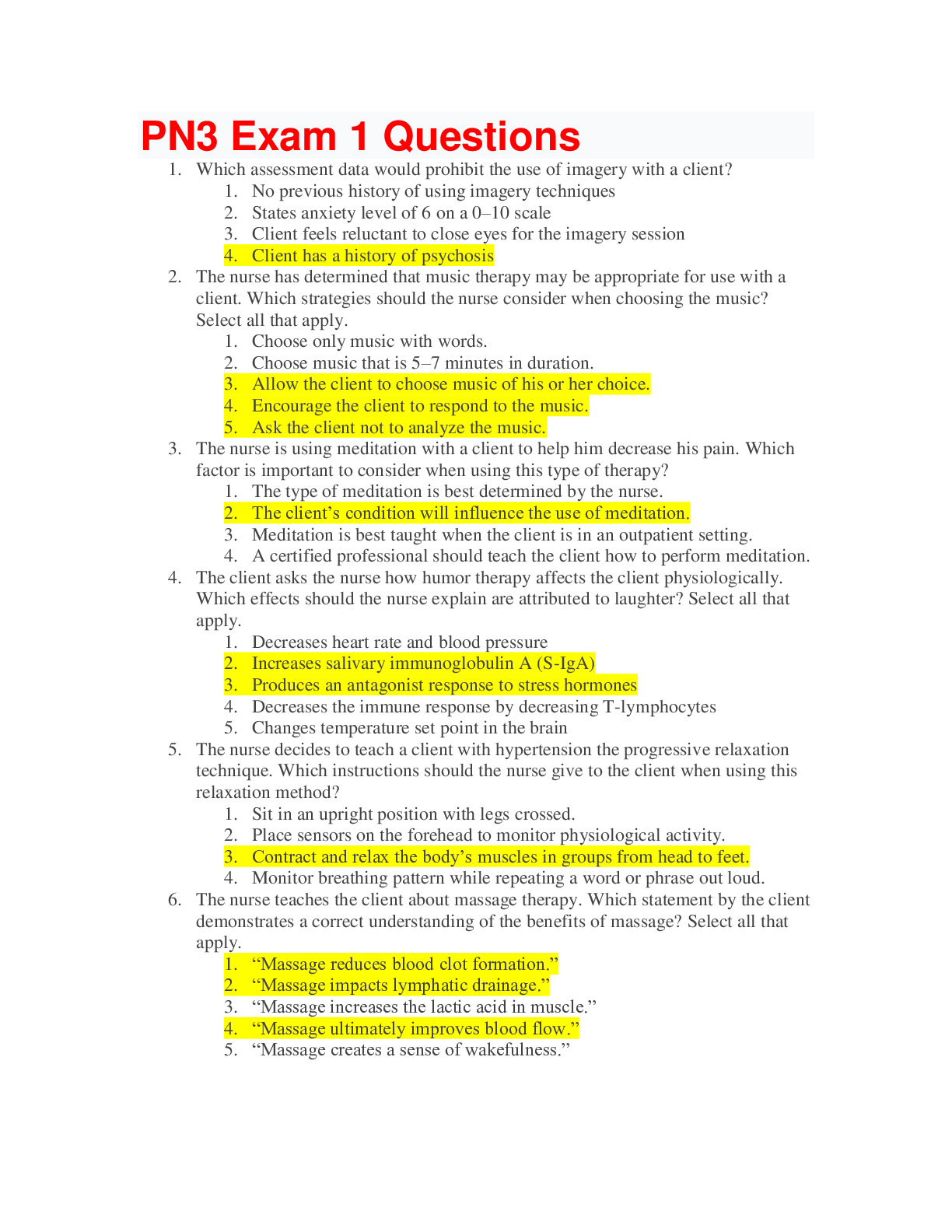
Reviews( 0 )
Document information
Connected school, study & course
About the document
Uploaded On
Jul 10, 2020
Number of pages
13
Written in
Additional information
This document has been written for:
Uploaded
Jul 10, 2020
Downloads
0
Views
47

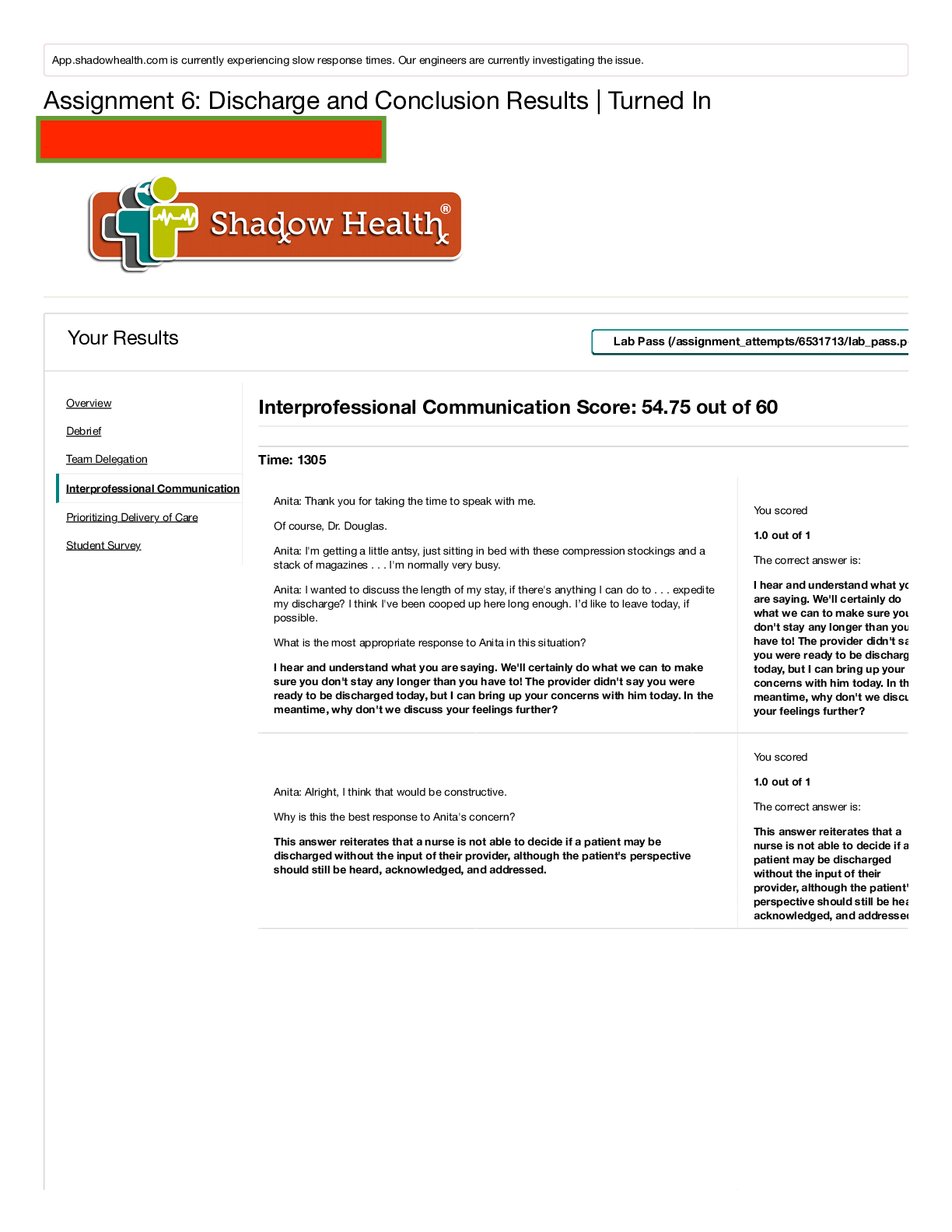
 Rasmussen College.png)

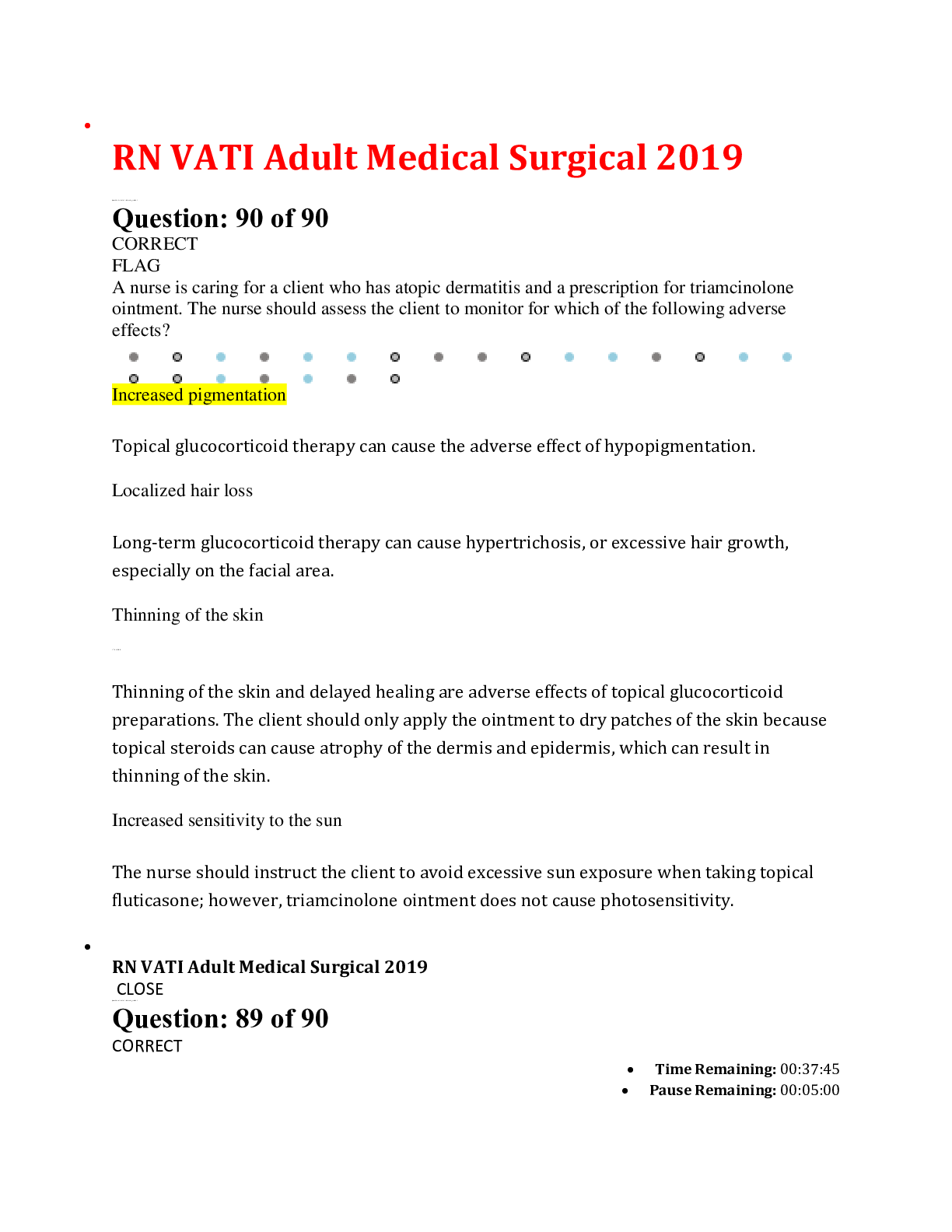
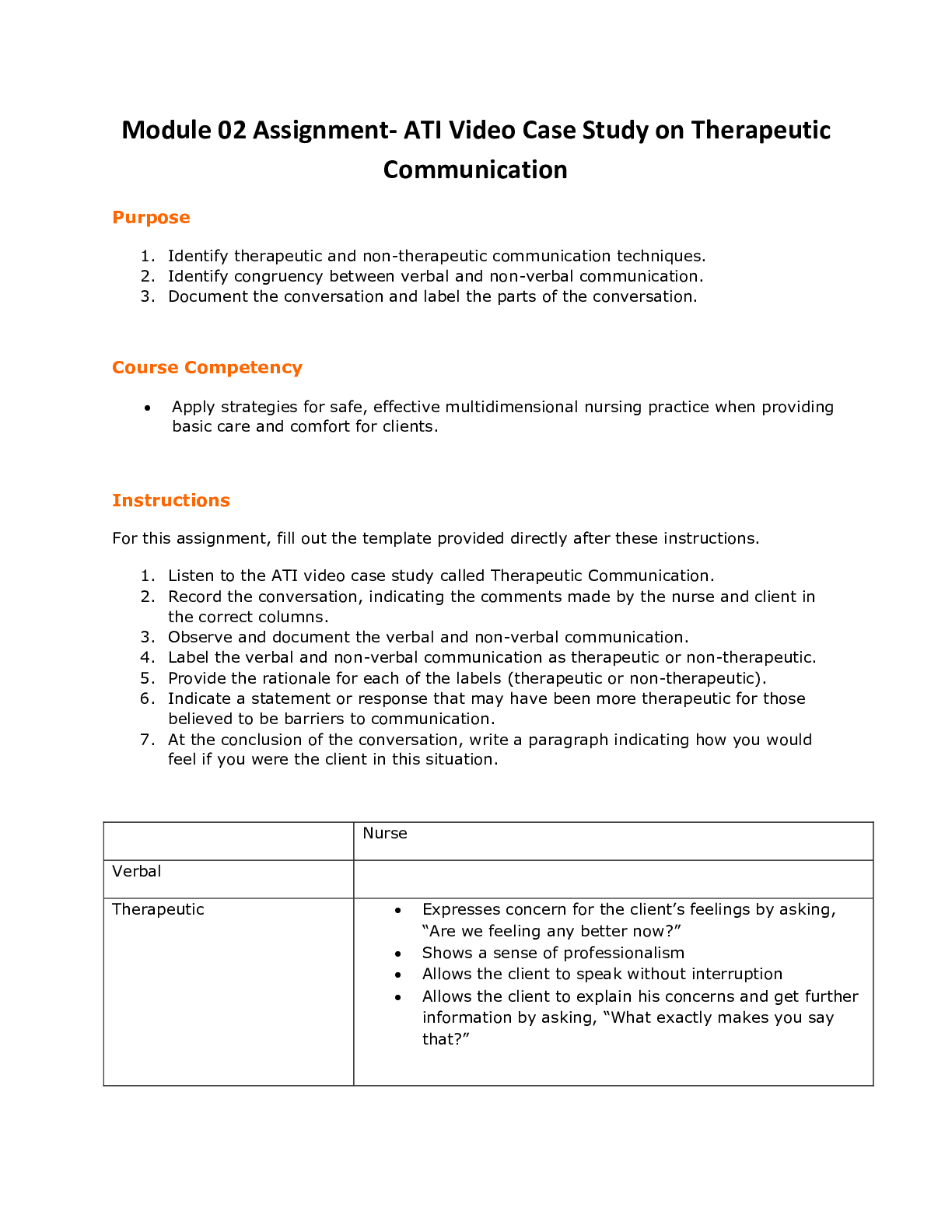

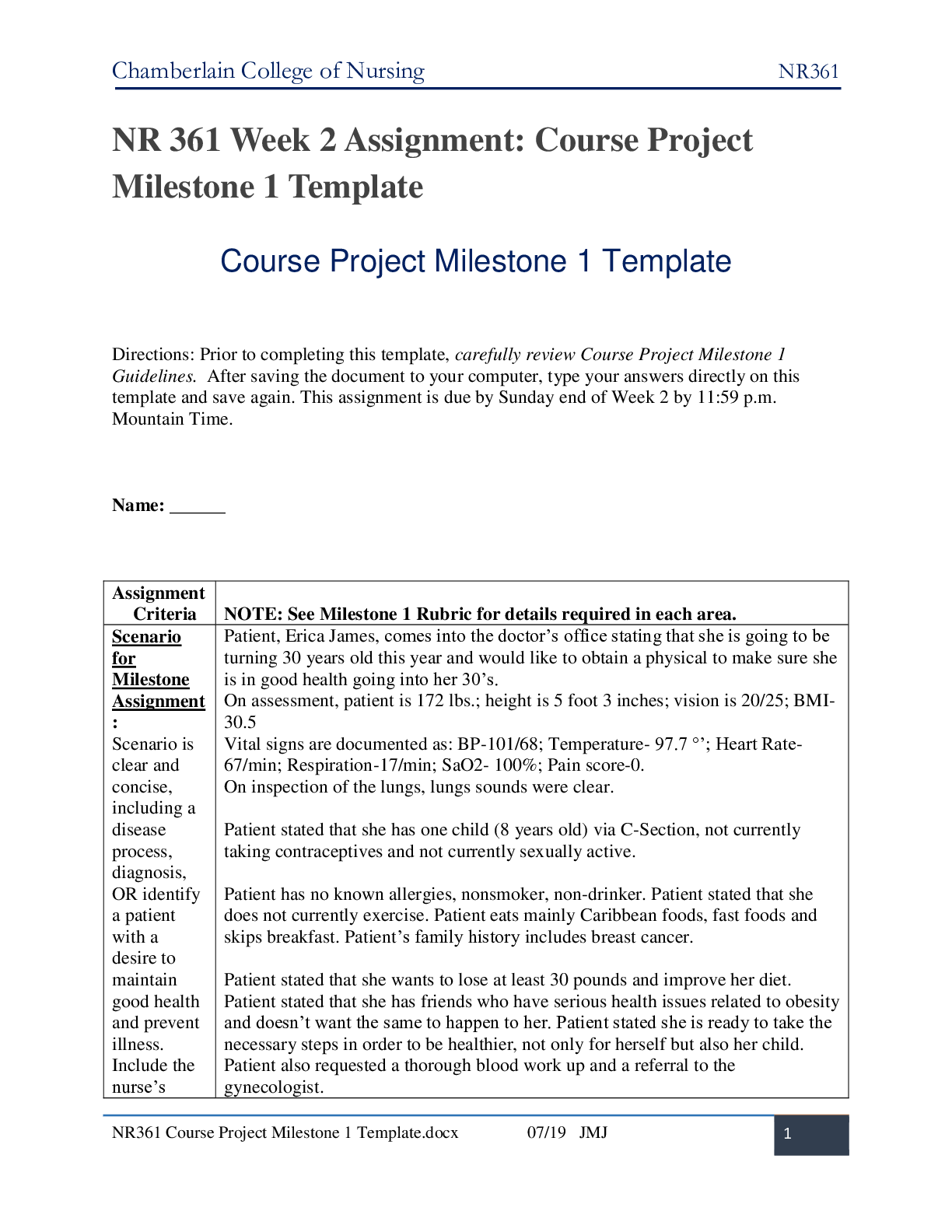
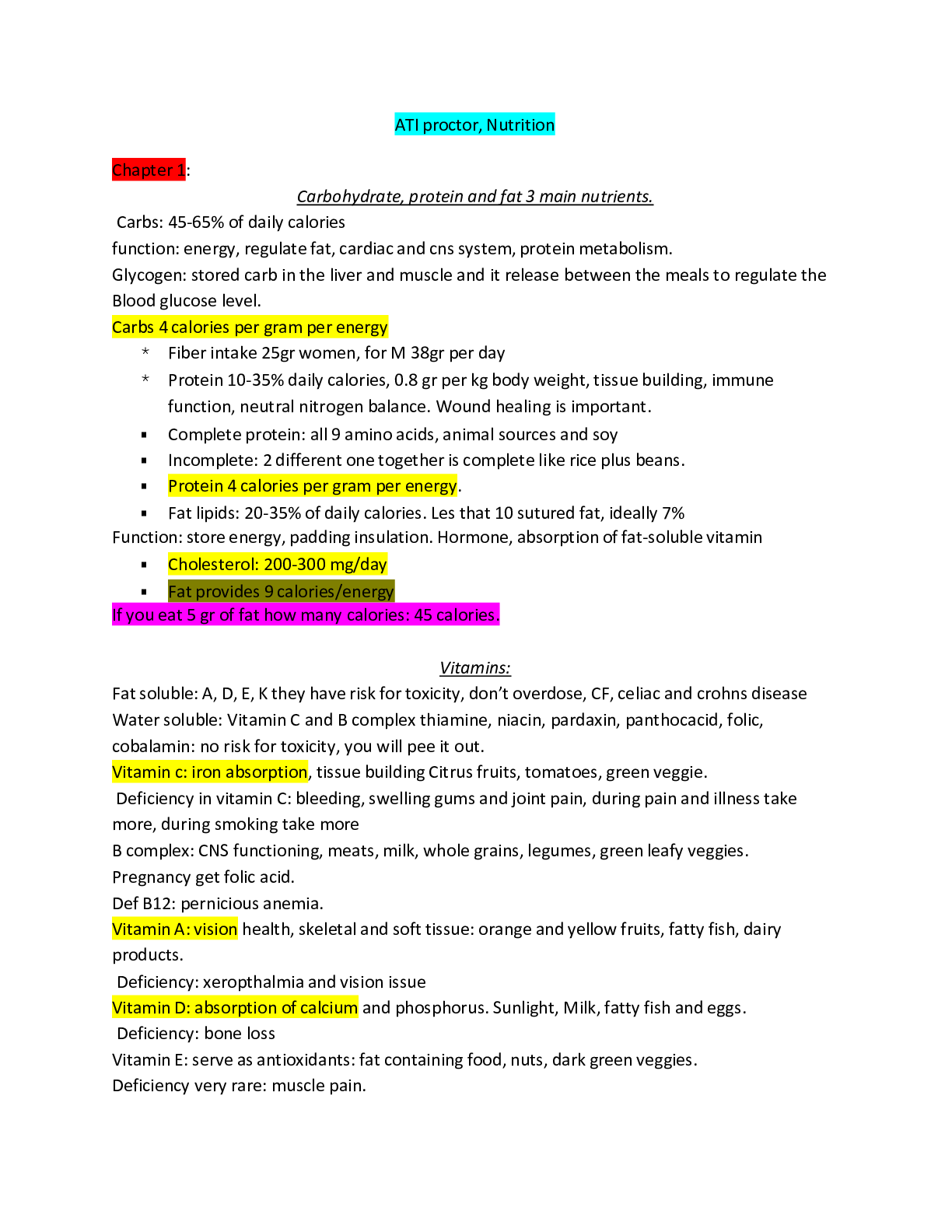
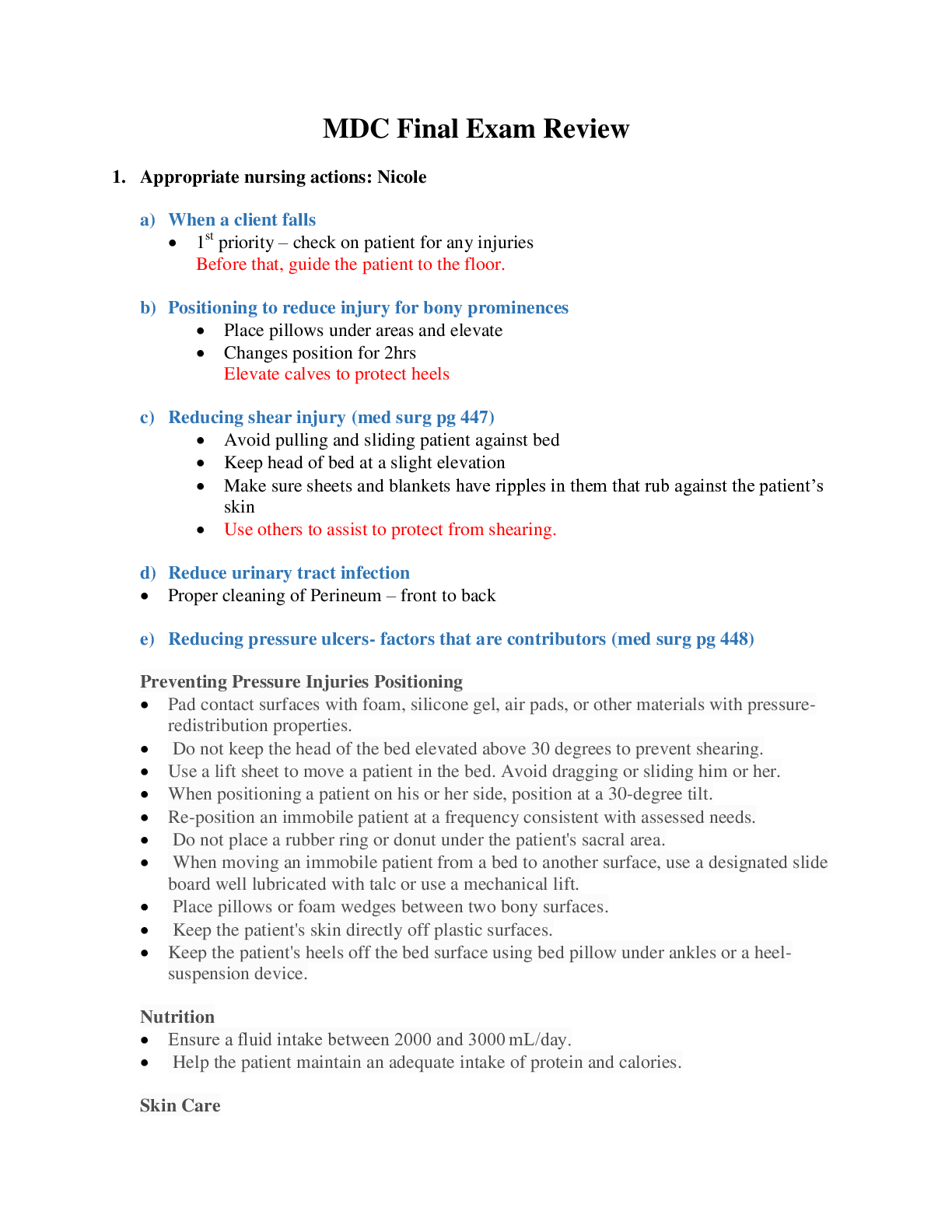
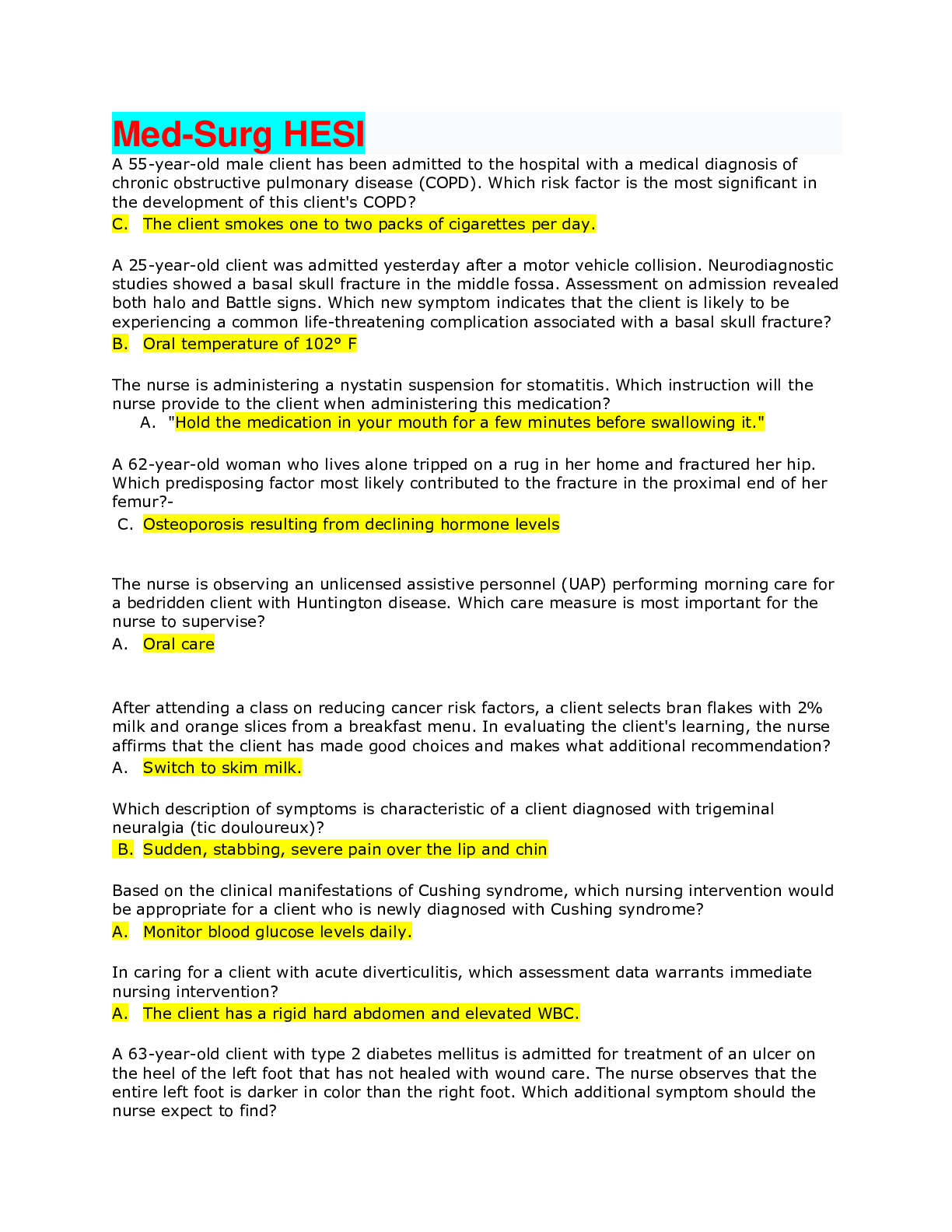

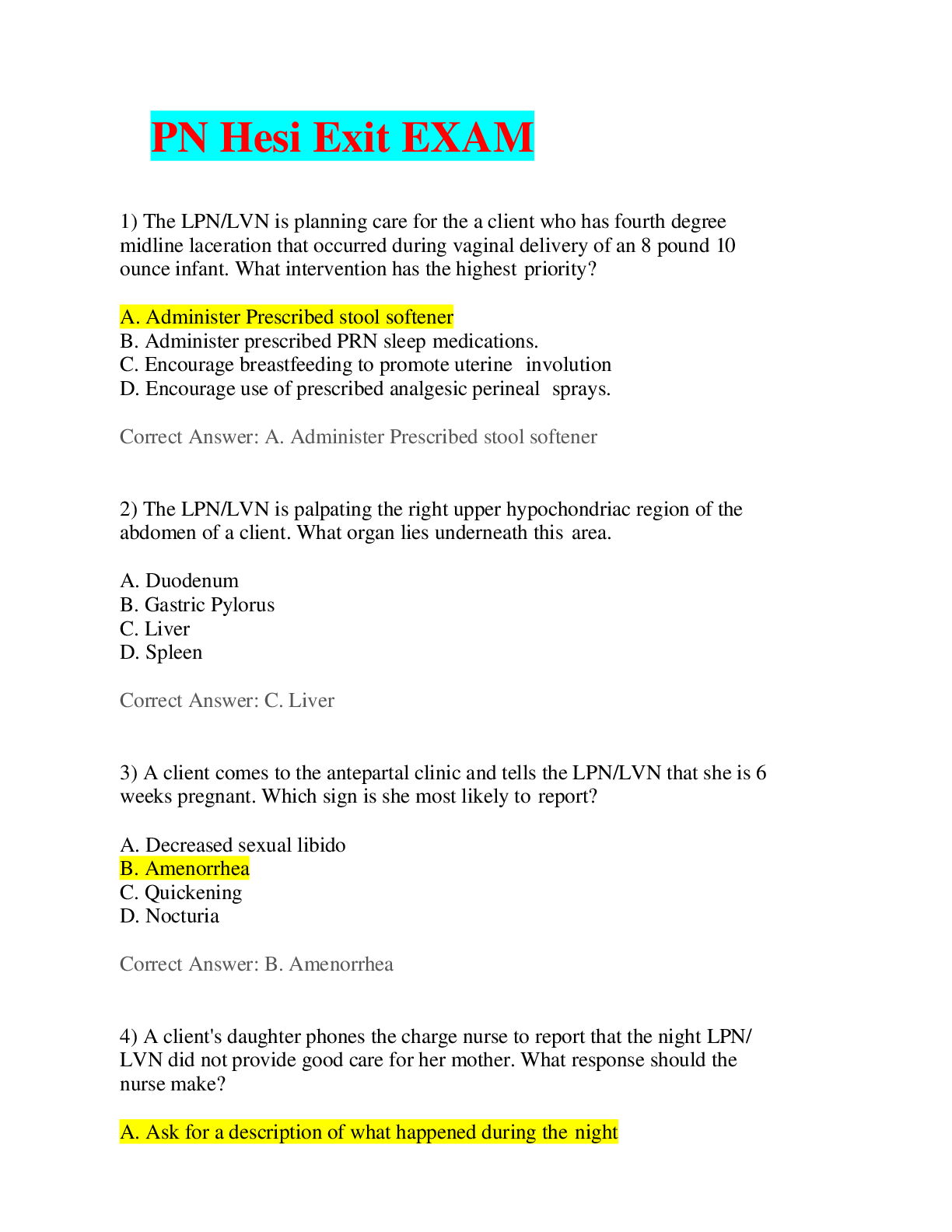
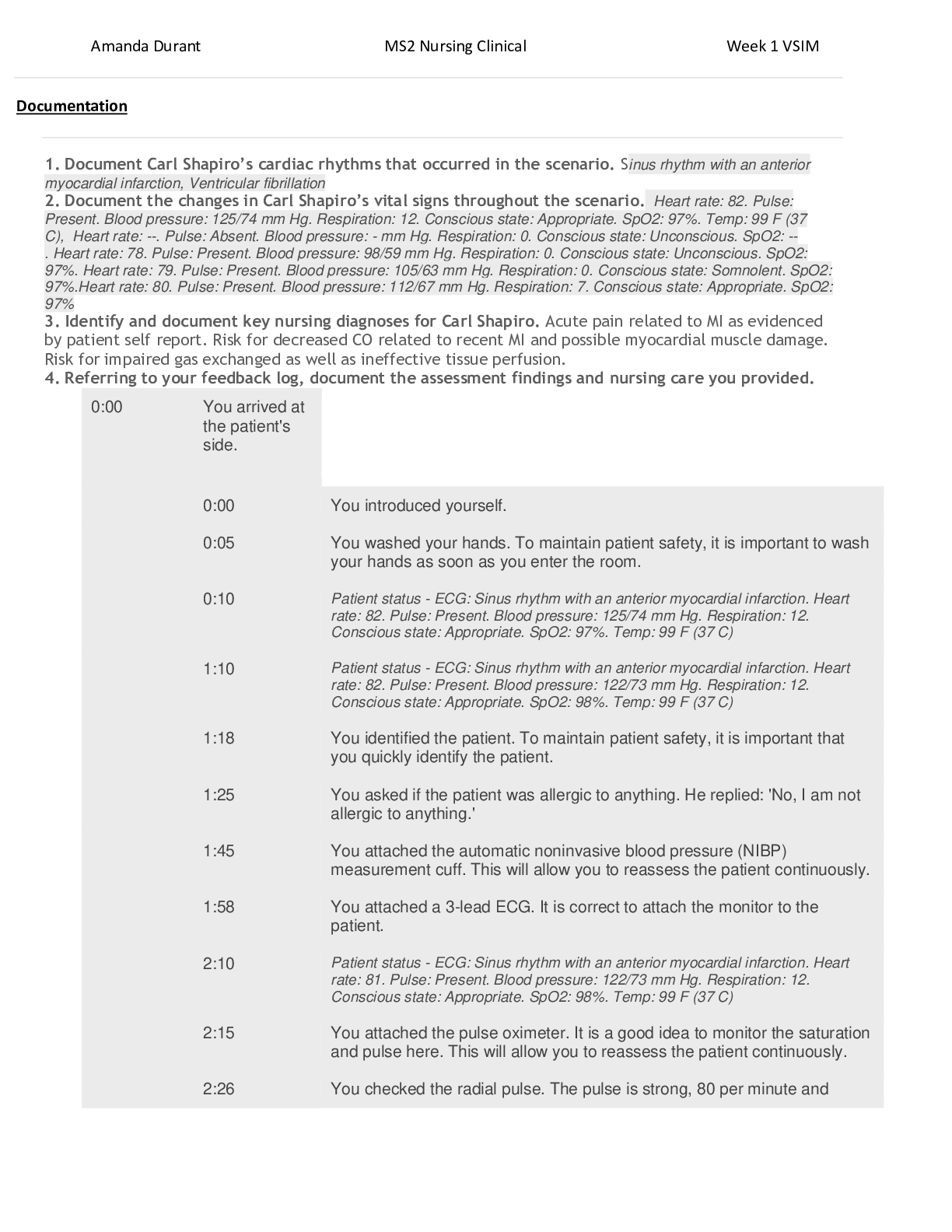

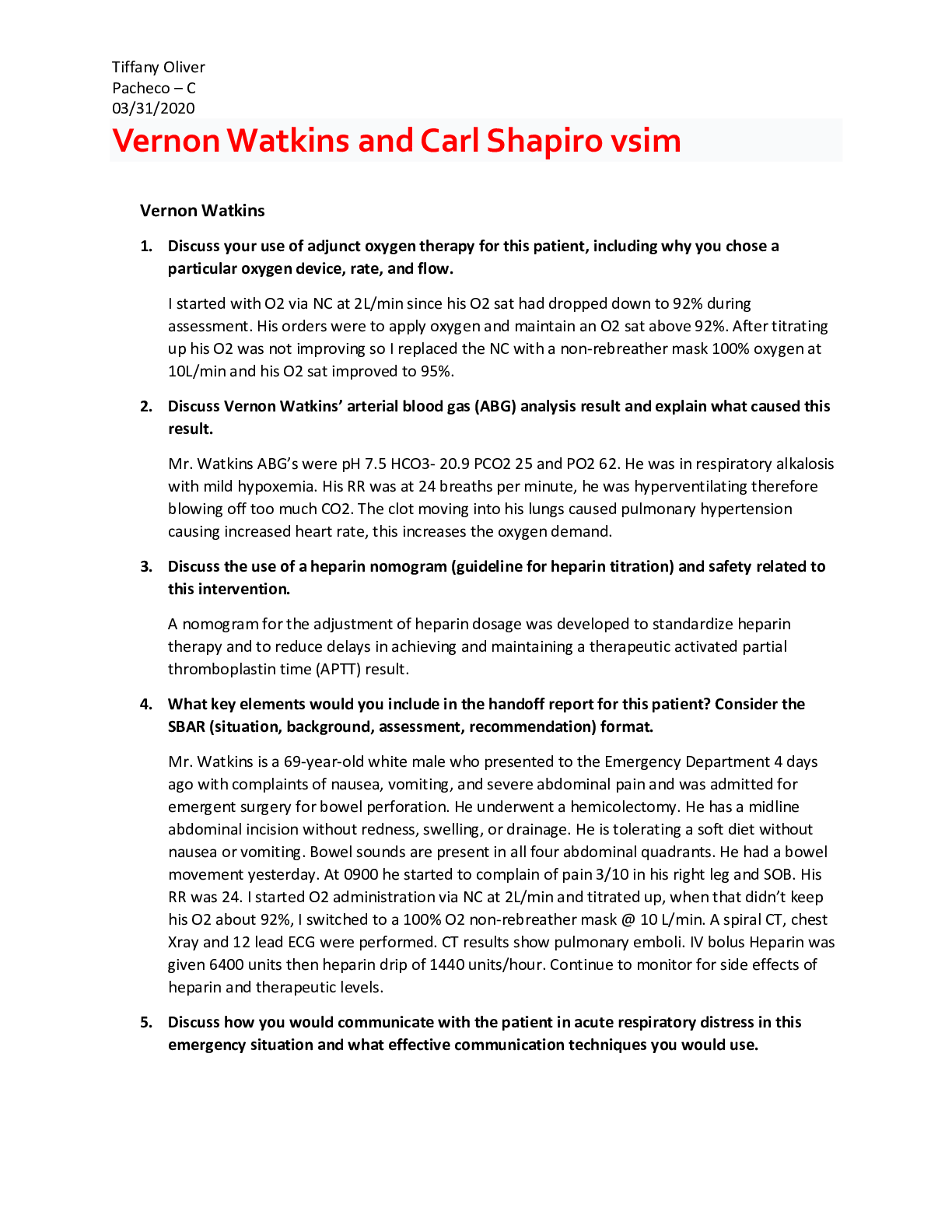
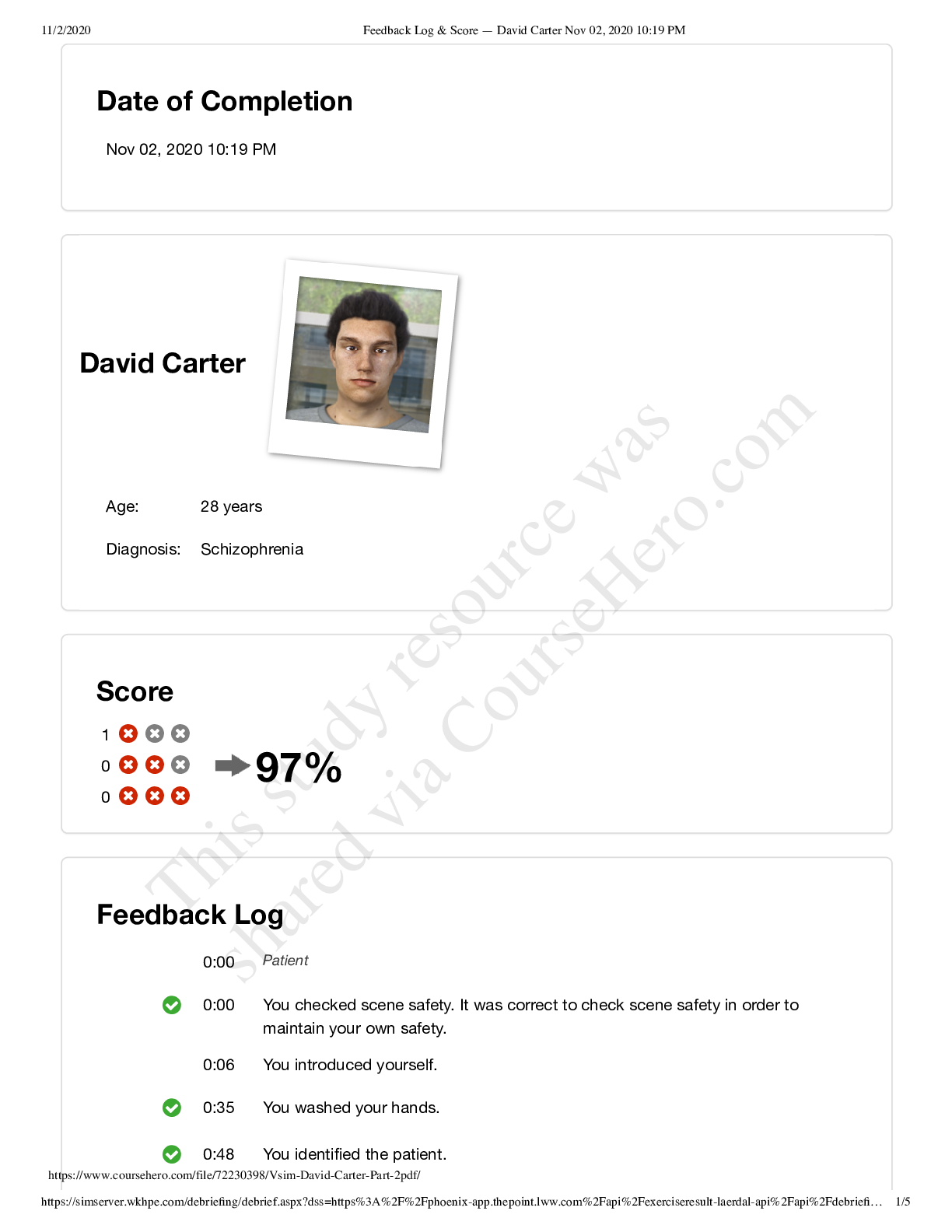
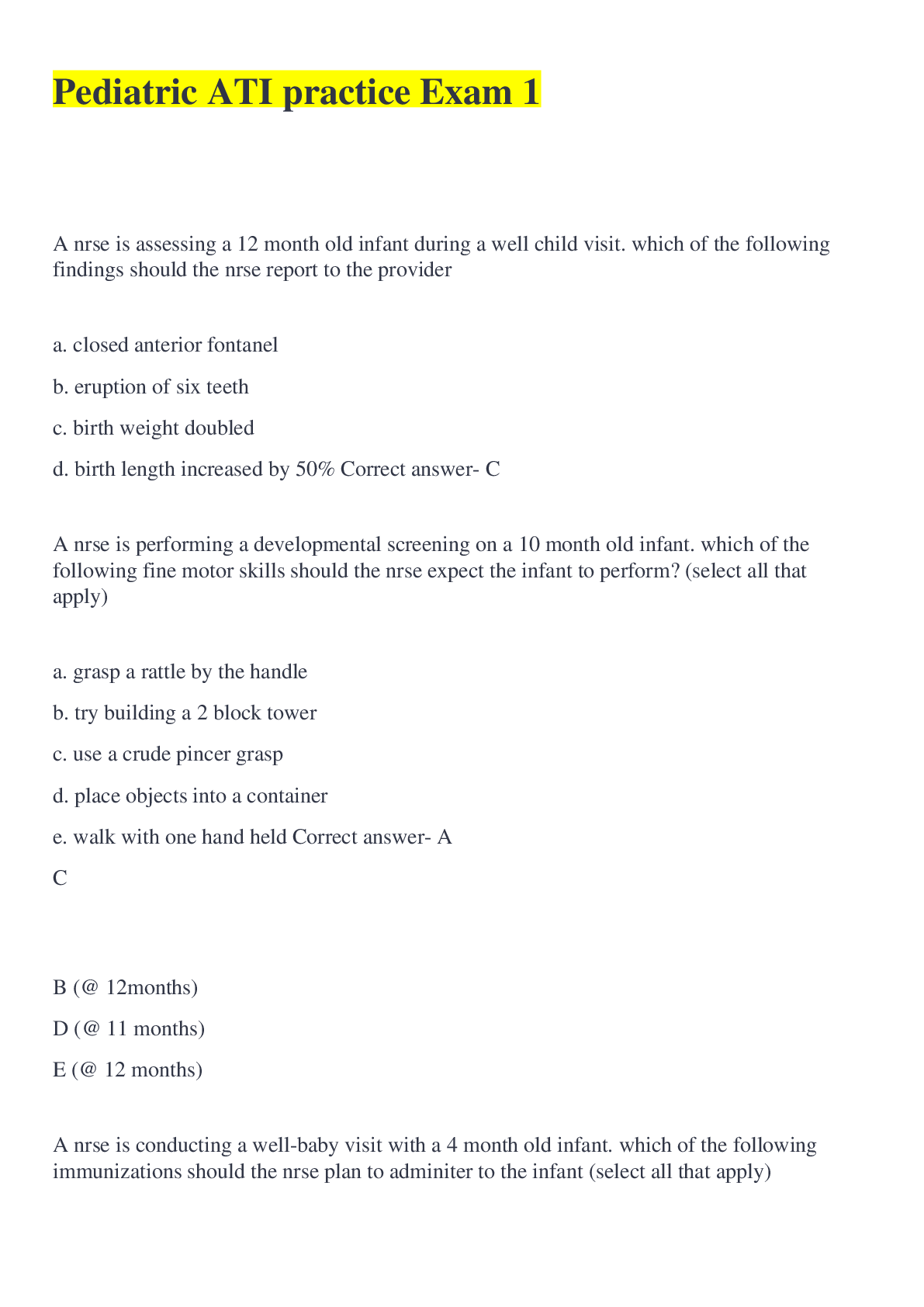
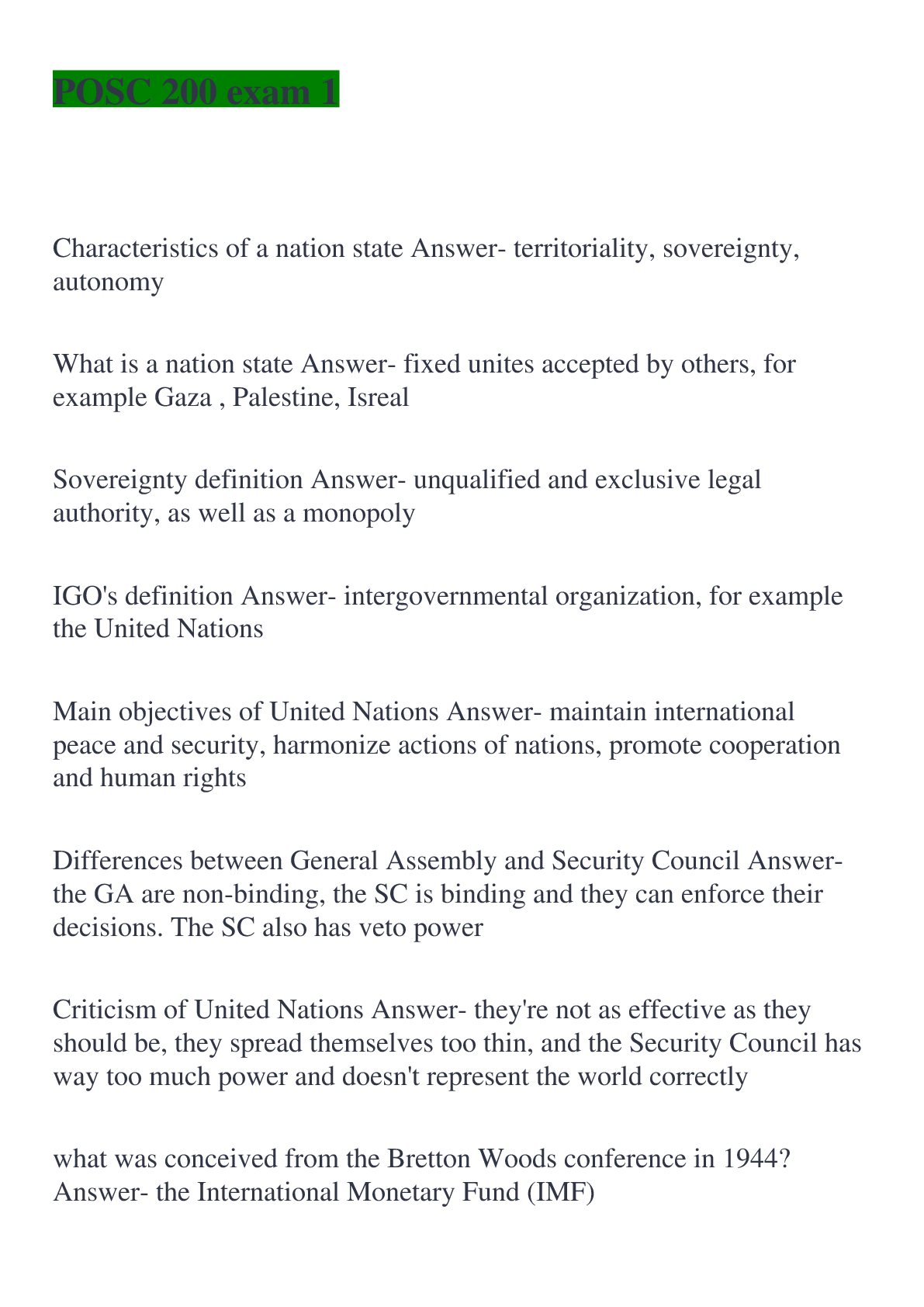
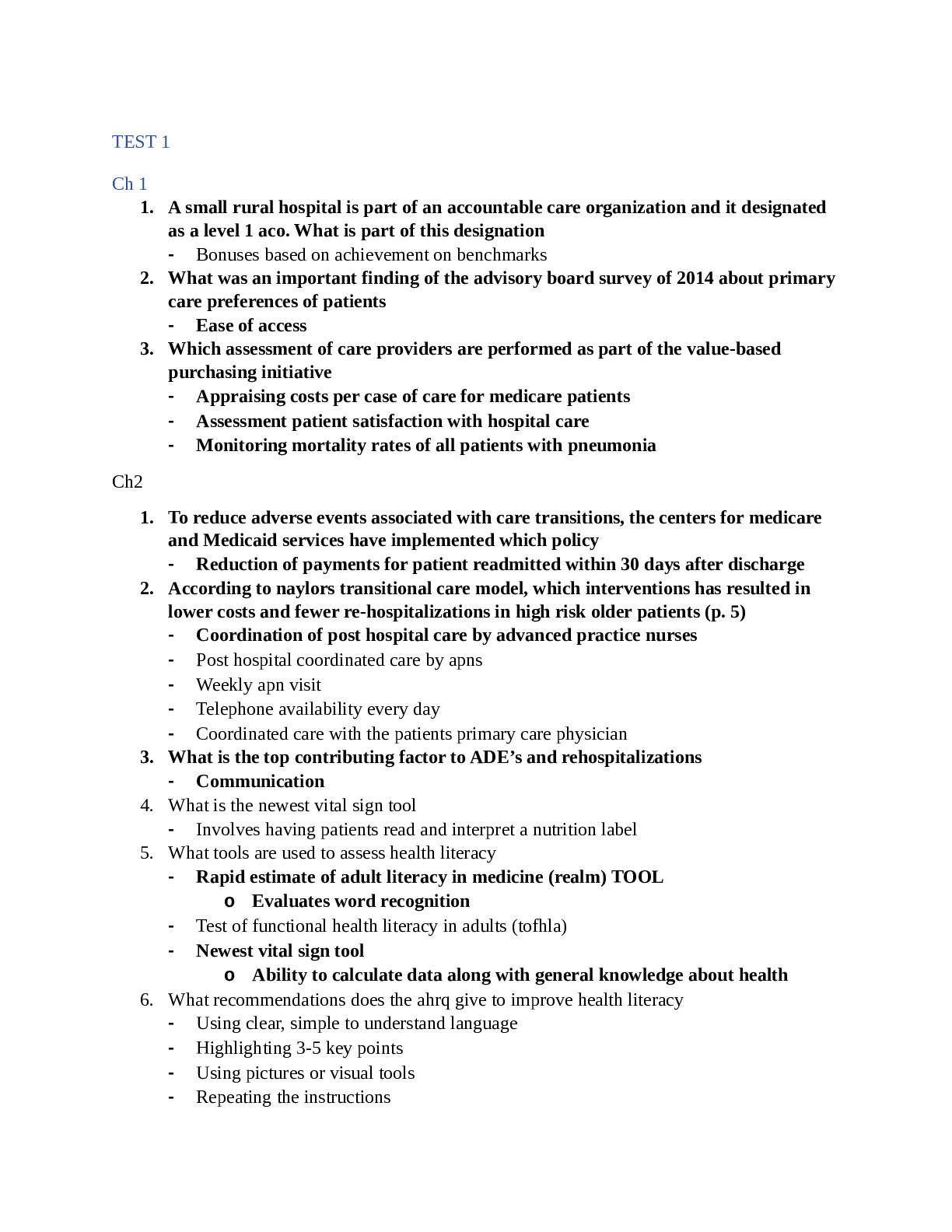
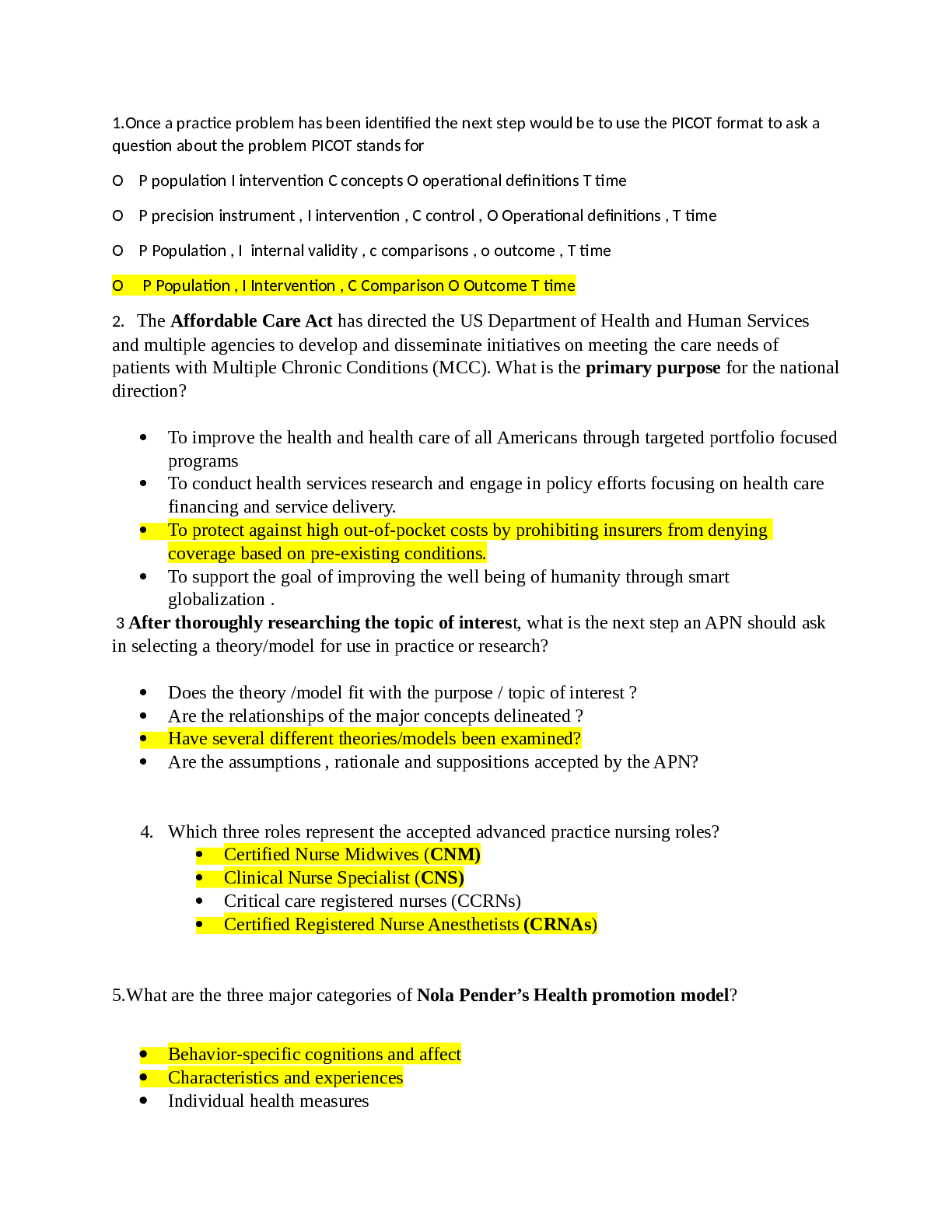
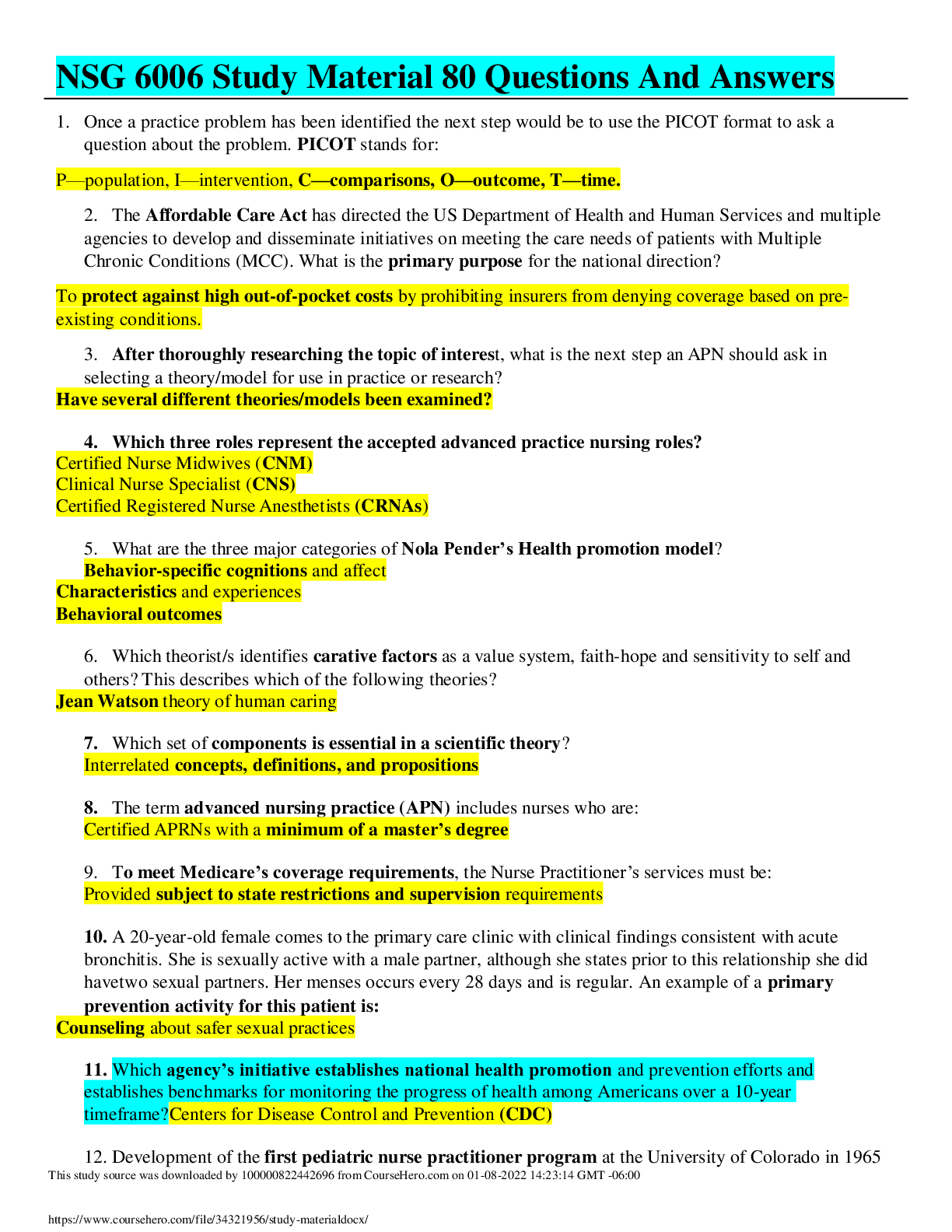
 Questions and Answers (latest Update), All Correct, Download to Score A.png)
 SOUTH UNIVERSITY (GRADED A).png)
, Correct, Download to Score A.png)
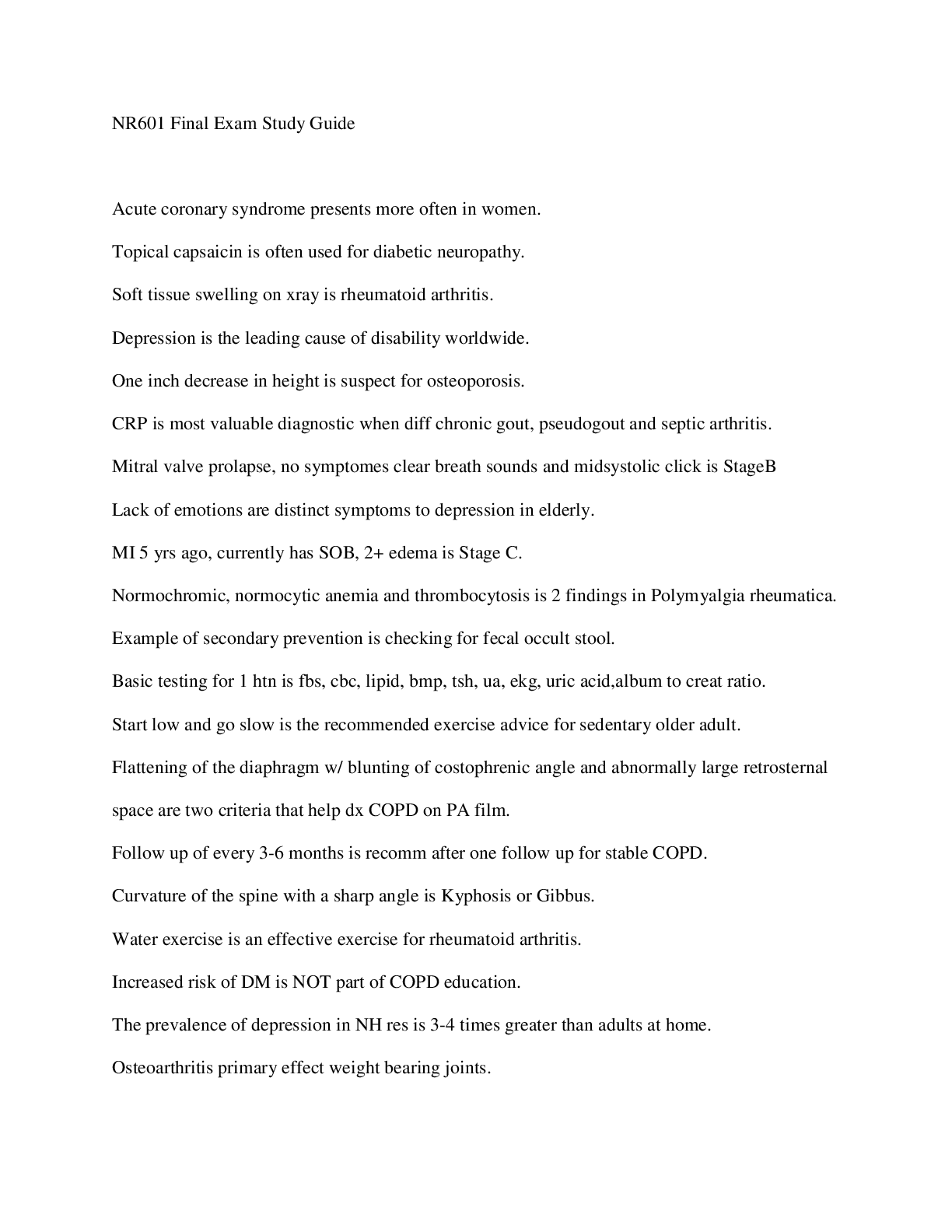
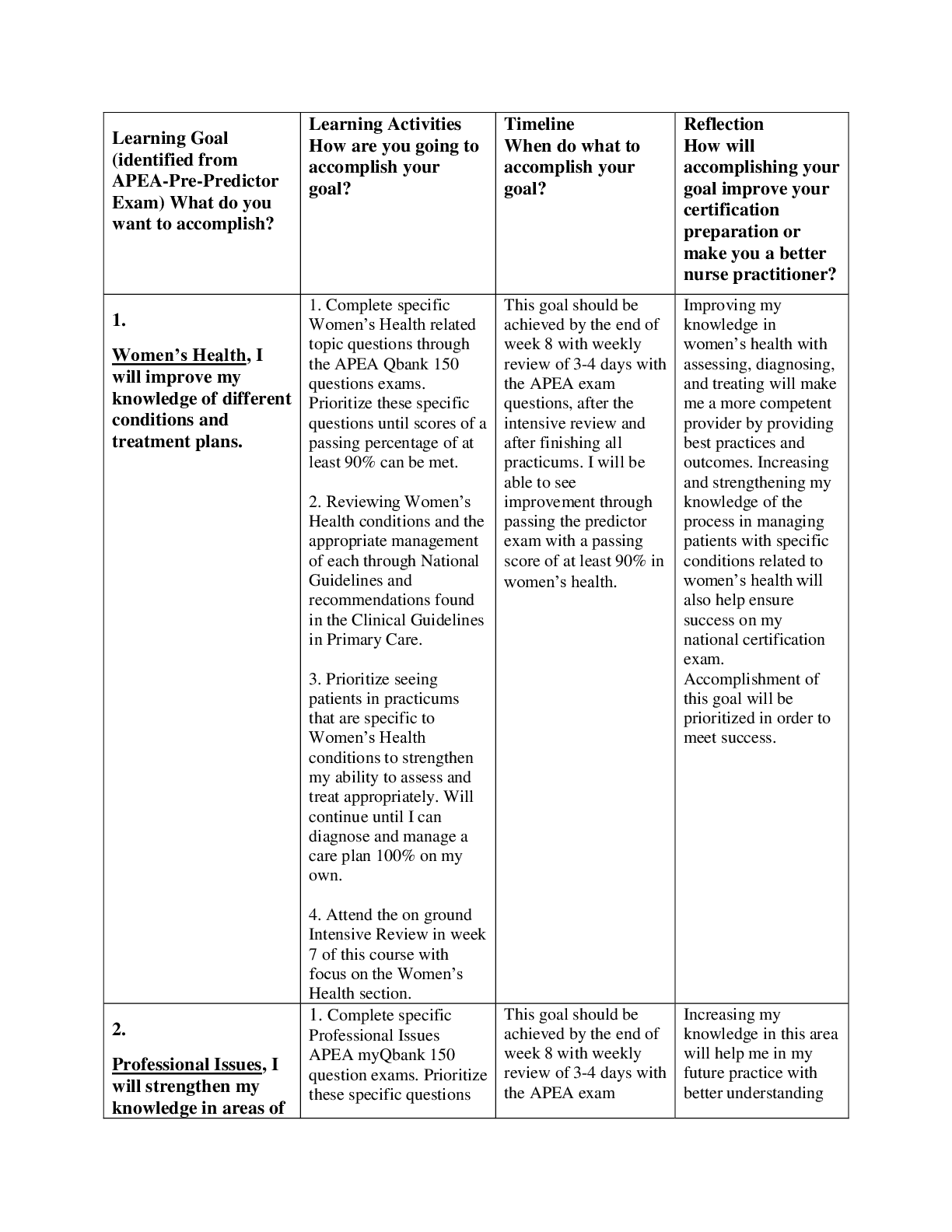
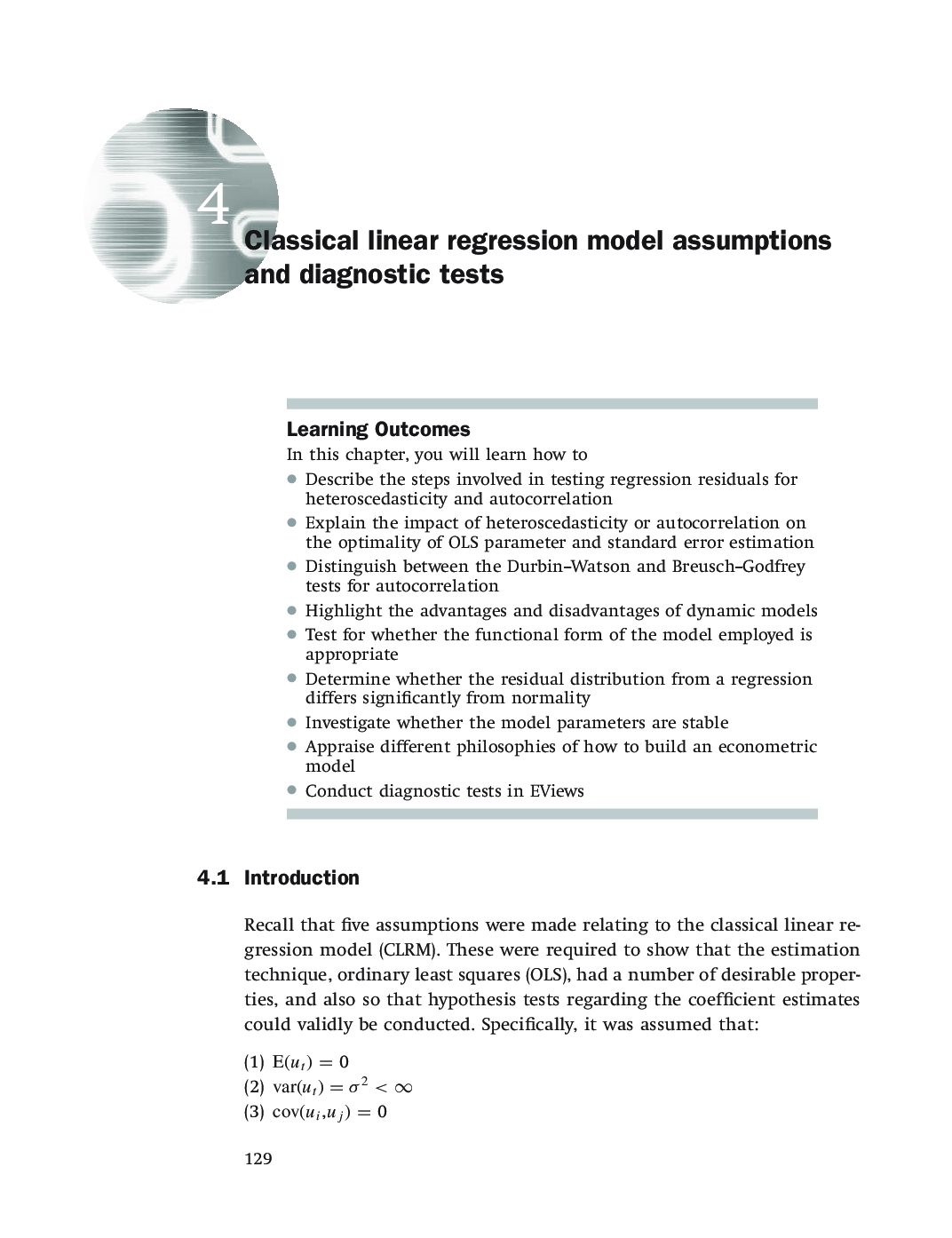
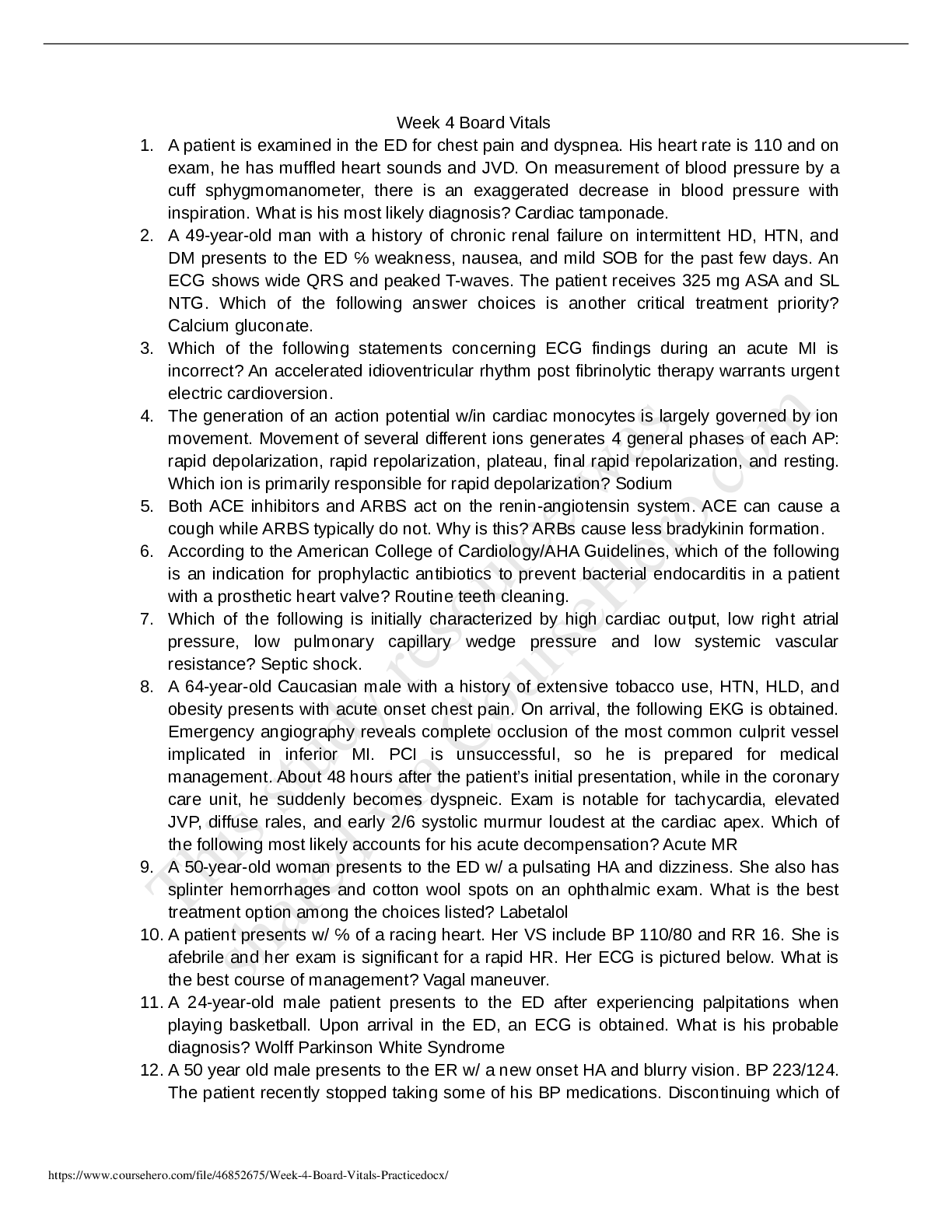
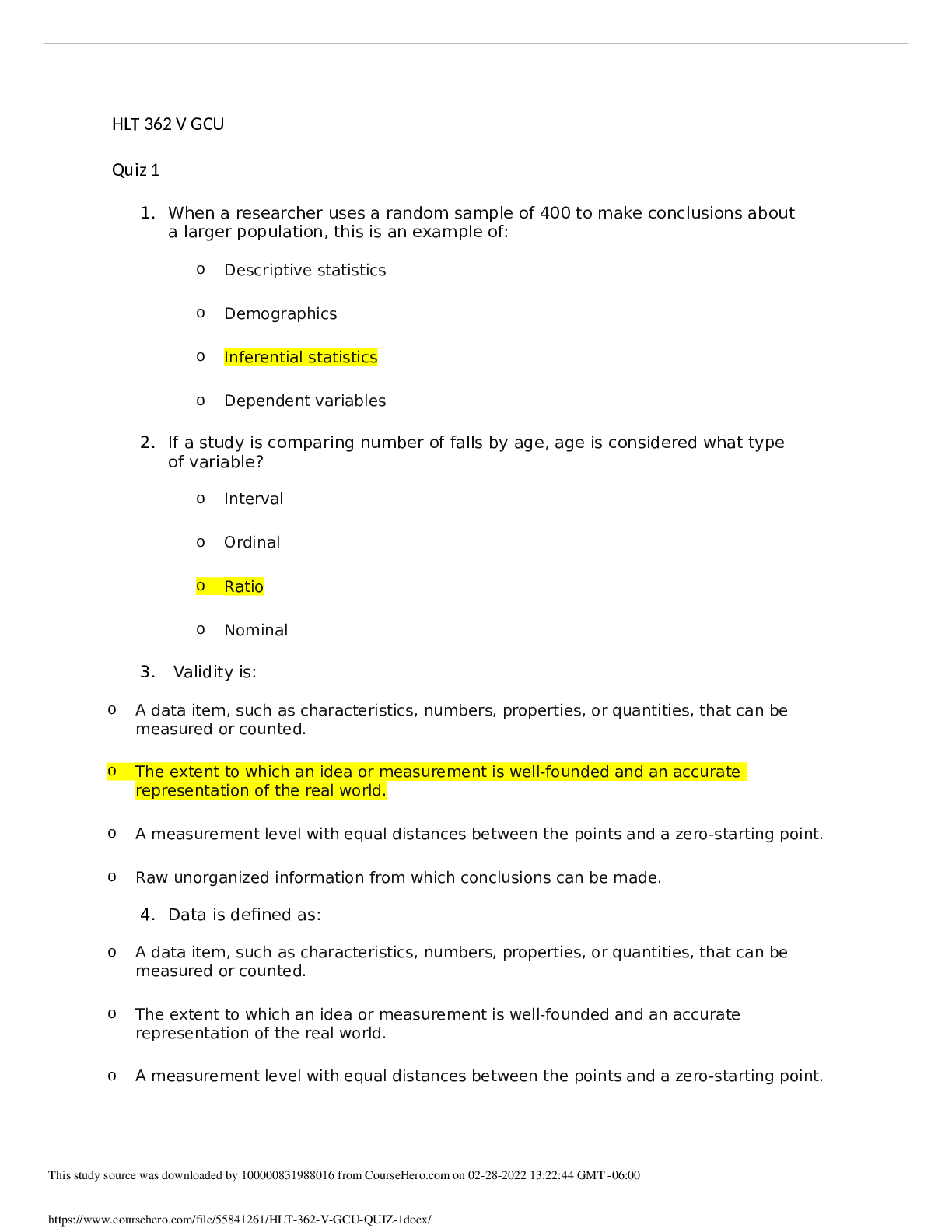
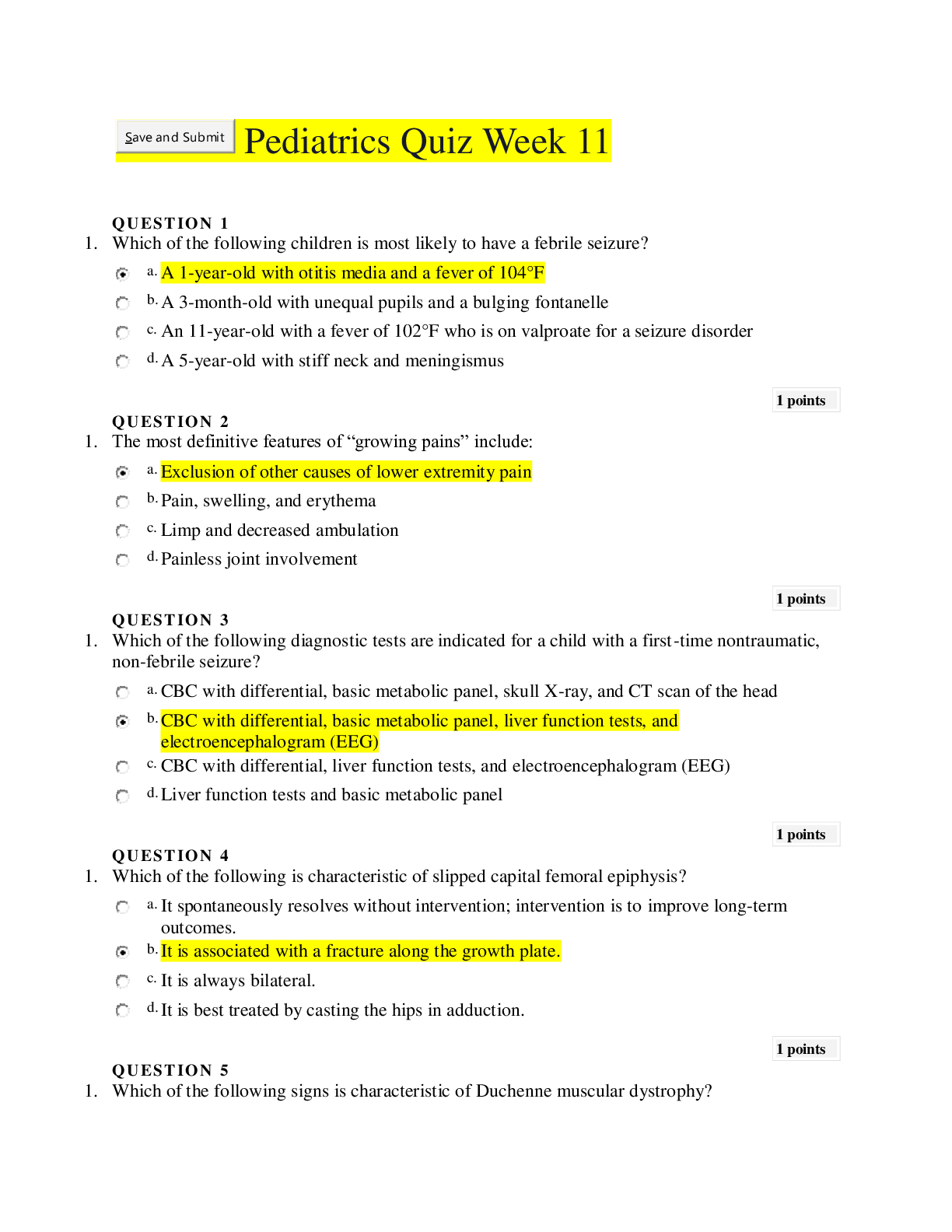
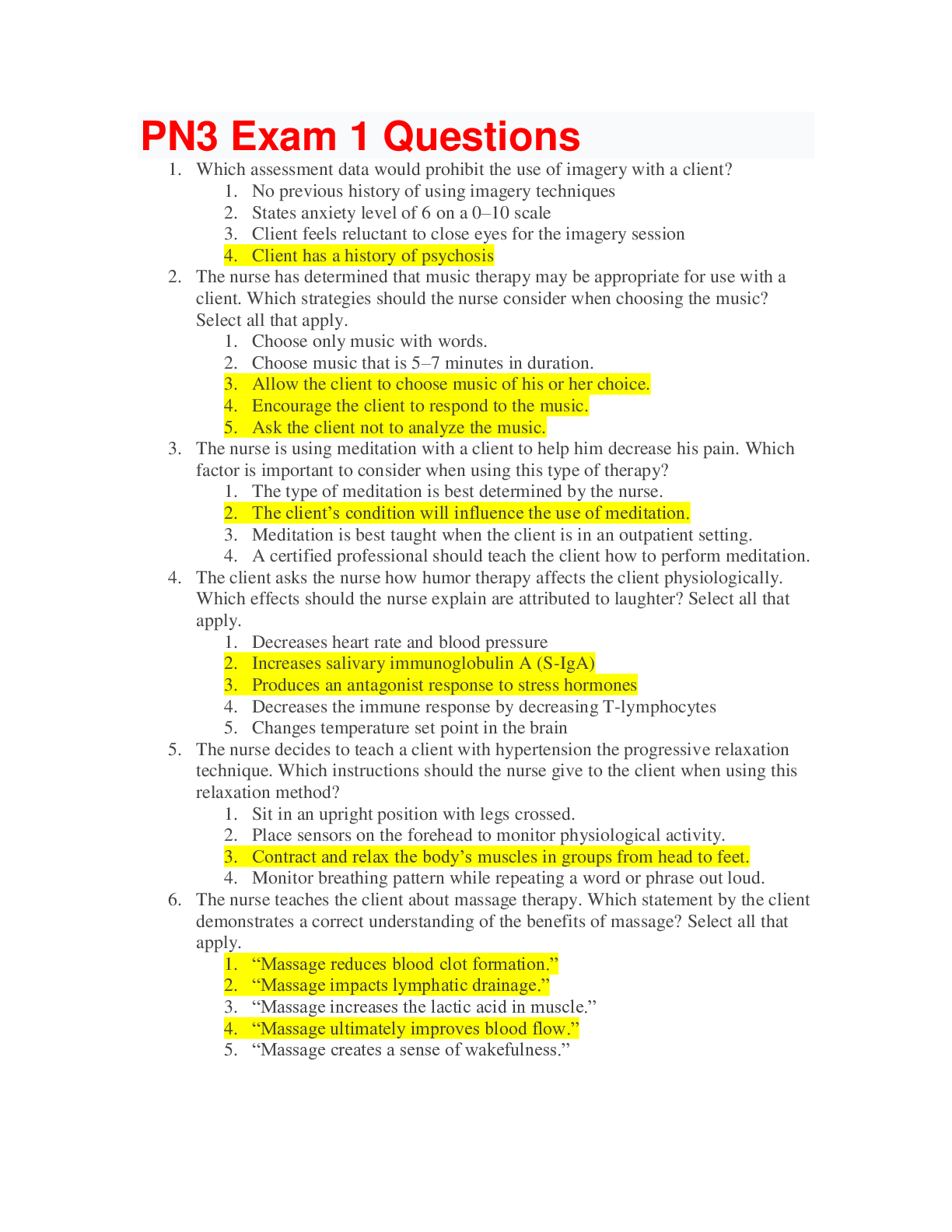
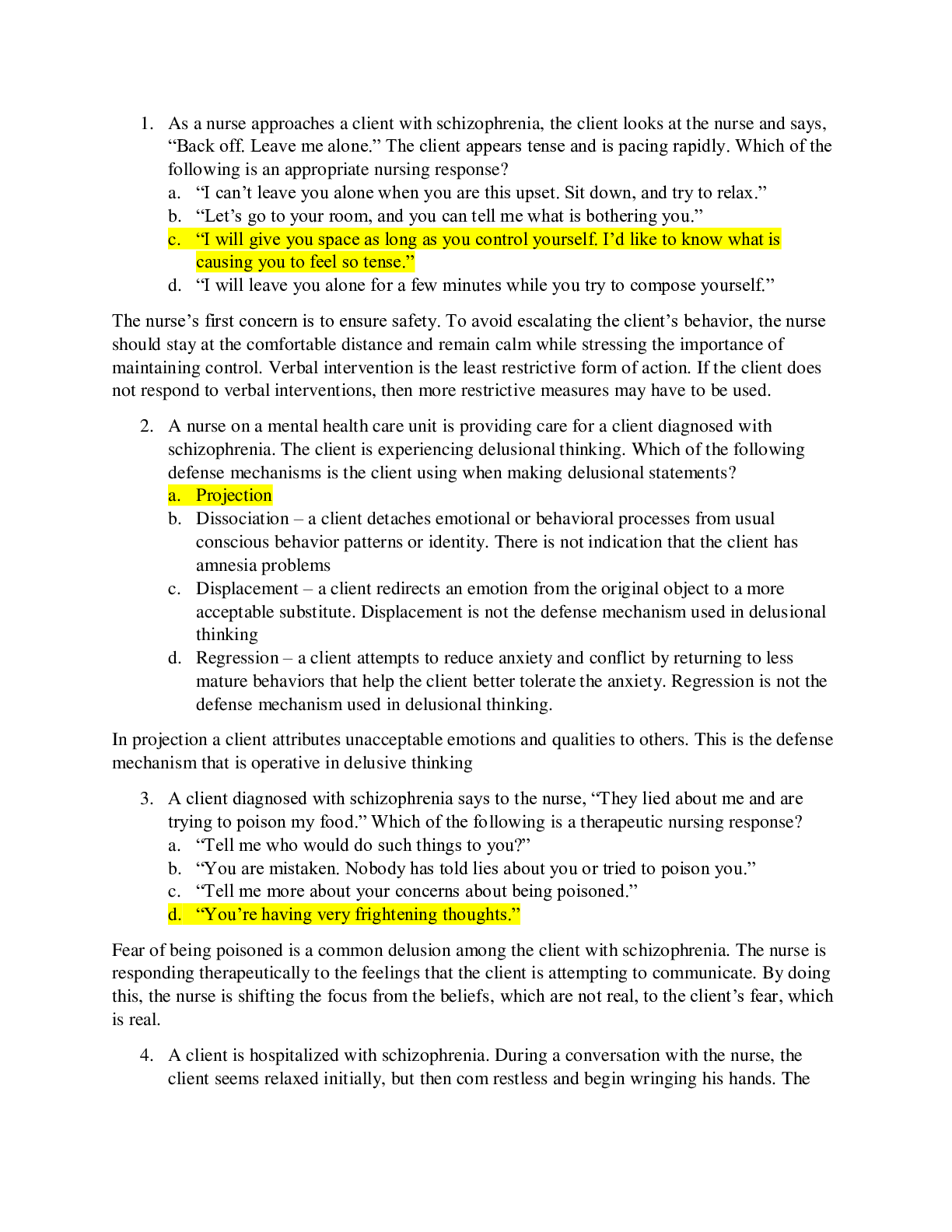
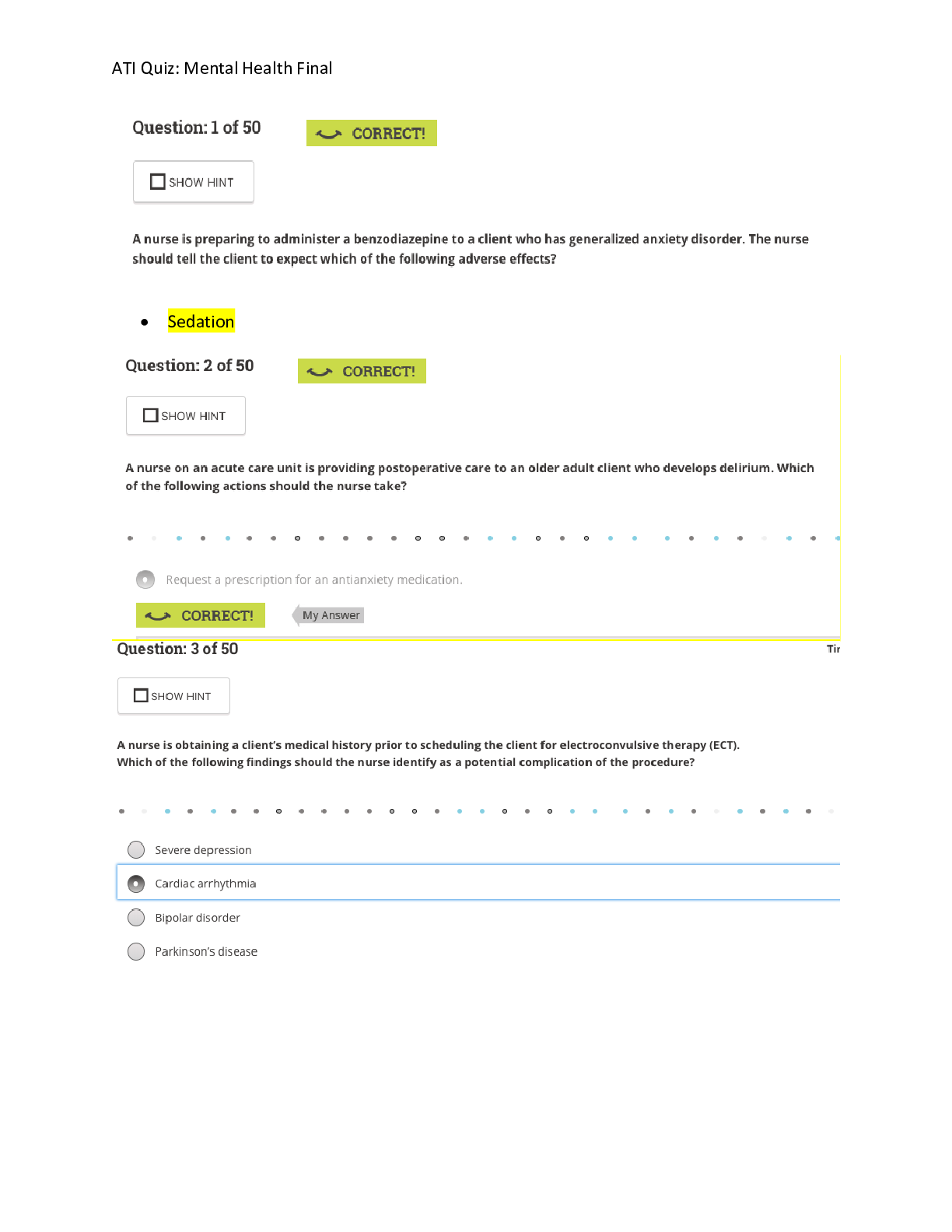
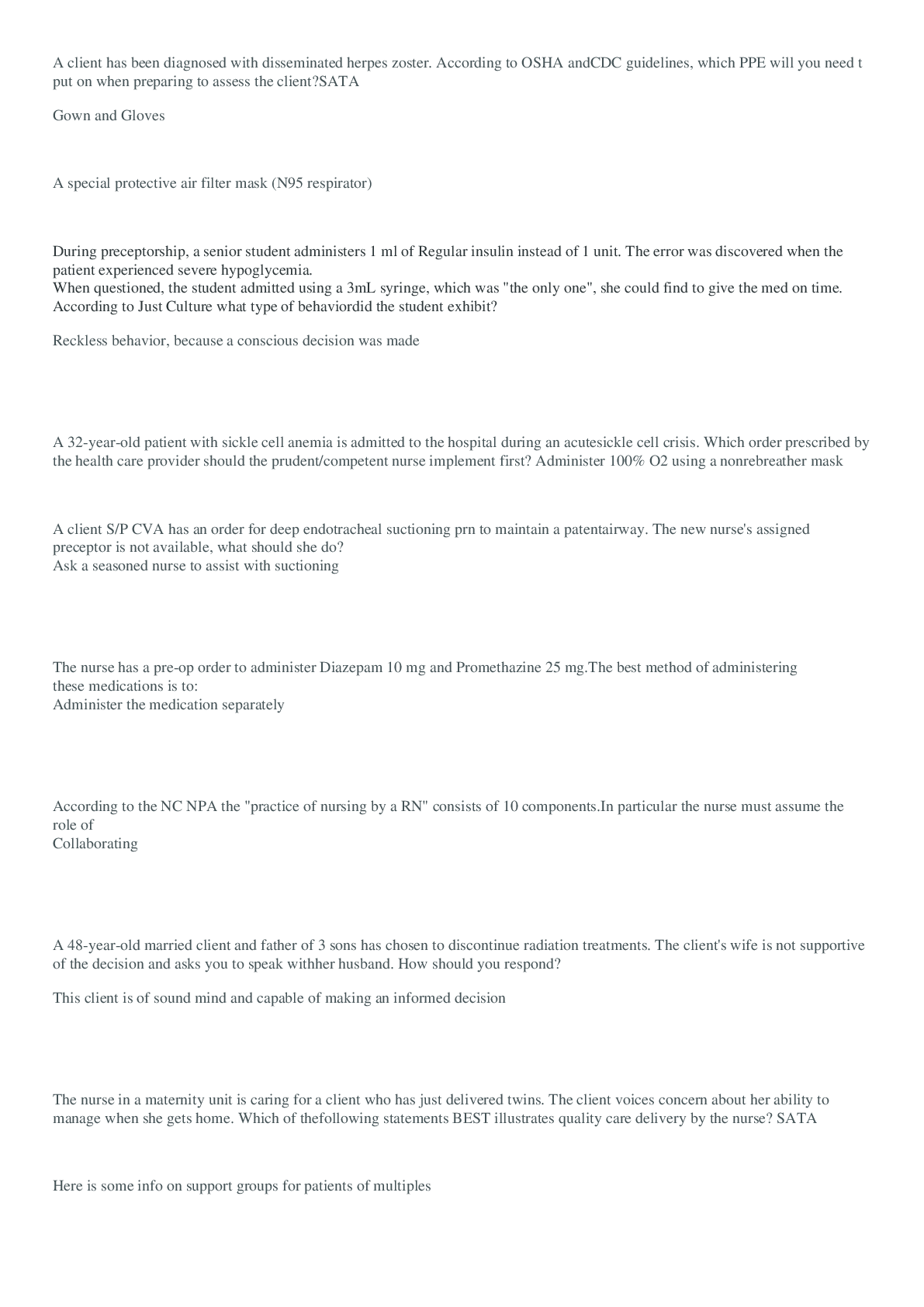
.png)

